On the Microstructure and Properties of Nb-18Si-6Mo-5Al-5Cr-2.5W-1Hf Nb-Silicide Based Alloys with Ge, Sn and Ti Additions (at.%)
Abstract
1. Introduction
- (a)
- With Al, Cr and Ti, it suppressed pest oxidation at 800 °C and scale spallation at 1200 °C in the alloy Nb-24Ti-18Si-5Al-5Cr-5Ge-5Sn (OHS1) [45]);
- (b)
- (c)
- With Al, Cr, Hf, Ta, Ti and W it (iii) suppressed pest oxidation at 800 °C and improved scale adhesion at 1200 °C in the alloy Nb-12Ti-18Si-6Ta-2.5W-1Hf-5Sn-5Ge-5Al-5Cr (JZ3) [47], the scale of which did not separate but was cracked along edges, (iv) did not suppress pest oxidation at 800 °C owing to micro-cracking of the alloy that was attributed to the high hardness of alloyed Nb5Si3 and the very low vol.% Nbss, and (v) suppressed scale spallation at 1200 °C when the Sn concentration was increased in the alloy Nb-12Ti-18Si-6Ta-2.5W-1Hf-7.5Sn-5Ge-5Al-5Cr (JZ3+) [47]; Nb5Si3 alloyed with Ge is desirable for creep and oxidation resistance [6] (the nominal compositions of alloys are also given in the Abbreviations).
2. Alloy Design
3. Experiment
4. Results
4.1. Microstructures
4.2. Oxidation
4.2.1. Oxidation at 800 °C
4.2.2. Oxidation at 1200 °C
5. Discussion
5.1. Density
5.2. Macrosegregation
5.3. Microstructures
5.4. Oxidation
5.4.1. Oxidation at 800 °C
5.4.2. Oxidation at 1200 °C
5.5. Further Comments on Experimental Data and NICE Calculations
6. Summary, and Suggestion for Future Work
Supplementary Materials
Author Contributions
Funding
Acknowledgments
Conflicts of Interest
Abbreviations
| CM1 | Nb-8.1Ti-21.1Si-5.4Mo-4W-0.7Hf |
| EZ8 | Nb-24Ti-18Si-5Al-5Cr-5Hf-5Sn |
| JG1 | Nb-18Si-5Al-5Cr-5Mo |
| JG2 | Nb-24Ti-18Si-5Al-5Cr-5Mo |
| JG3 | Nb-24Ti-18Si-5Al-5Cr-2Mo |
| JG4 | Nb-24Ti-18Si-5Al-5Cr-5Hf-2Mo |
| JG6 | Nb-24Ti-18Si-5Al-5Cr-5Hf-5Sn-2Mo |
| JZ1 | Nb-12Ti-18Si-6Ta-2.5W-1Hf-2Sn-2Ge |
| JZ2 | Nb-12Ti-18Si-6Ta-2.5W-1Hf-5Sn-5Ge |
| JZ3 | Nb-12Ti-18Si-6Ta-2.5W-1Hf-5Sn-5Ge-5Al-5Cr |
| JZ3+ | Nb-12Ti-18Si-6Ta-2.5W-1Hf-7.5Sn-5Ge-5Al-5Cr |
| KZ2 | Nb-24Ti-18Si-8Cr-4Al |
| KZ5 | Nb-24Ti-18Si-5Al-5Cr |
| KZ6 | Nb-24Ti-18Si-6Ta-5Al-5Cr |
| KZ7 | Nb-24Ti-18Si-5Al |
| KZ8 | Nb-24Ti-18Si-8Cr-4Al |
| MASC | Nb-25Ti-16Si-8Hf-2Al-2Cr |
| OHS1 | Nb-24Ti-18Si-5Al-5Cr-5Ge-5Sn |
| YG6 | Nb-20Si-5Mo-3W |
| ZF1 | Nb-18Si-5Ge |
| ZF5 | Nb-24Ti-18Si-5Al-5Ge |
| ZF6 | Nb-24Ti-18Si-5Al-5Cr-5Ge |
| ZF9 | Nb-24Ti-18Si-5Al-5Cr-5Ge-5Hf |
| ZX7 | Nb-24Ti-18Si-5Al-5Cr-2Sn |
| ZX8 | Nb-24Ti-18Si-5Al-5Cr-5Sn |
Appendix A
References
- Tsakiropoulos, P. Alloys for application at ultra-high temperatures: Nb-silicide in situ composites. Challenges, breakthroughs and opportunities. Prog. Mater. Sci. 2020, 100714. [Google Scholar] [CrossRef]
- Senkov, O.; Miracle, D.B.; Chaput, K.J.; Couzinie, J.-P. Development and exploration of refractory high entropy alloys—A review. J. Mater. Res. 2018, 33, 3092–3128. [Google Scholar] [CrossRef]
- Bewlay, B.P.; Jackson, M.R.; Gigliotti, M.F.X. Niobium Silicide High Temperature In Situ Composites. In Intermetallic Compounds—Principles and Practice; Wiley: Hoboken, NJ, USA, 2002; Volume 3, pp. 541–560. [Google Scholar]
- Schneibel, J.H. Beyond Nickel-Base Superalloys. In Processing and Fabrication of Advanced Materials XIII; Stallion Press: Singapore, 2005; Volume 2. [Google Scholar]
- Perepezko, J.H. The hotter the engine, the better. Science 2009, 326, 1068–1069. [Google Scholar] [CrossRef] [PubMed]
- Bewlay, B.P.; Jackson, M.R.; Zhao, J.-C.; Subramanian, P.R.; Mendiratta, M.G.; Lewandowski, J.J. Ultrahigh-Temperature Nb-Silicide-Based Composites. MRS Bull. 2003, 28, 646–653. [Google Scholar] [CrossRef]
- Tsakiropoulos, P. On the Nb silicide based alloys: Part I—The bcc Nb solid solution. J. Alloy. Compd. 2017, 708, 961–971. [Google Scholar] [CrossRef]
- Mendiratta, M.; Dimiduk, D. Phase relations and transformation kinetics in the high Nb region of the Nb-Si system. Scr. Met. Et Mater. 1991, 25, 237–242. [Google Scholar] [CrossRef]
- Kassem, M.A.; Koch, C.C. Effect of Interstitials on the Phase Stability of Selected Intermetallics. In MRS Proceedings; Cambridge University Press: Cambridge, UK, 1990; Volume 213, pp. 801–806. [Google Scholar]
- Jackson, M.R.; Bewlay, B.P.; Rowe, R.G.; Skelly, D.W.; Lipsitt, H.A. High-temperature refractory metal-intermetallic composites. JOM 1996, 48, 39–44. [Google Scholar] [CrossRef]
- Samant, A.V.; Lewandowski, J.J. Effects of test temperature, grain size, and alloy additions on the cleavage fracture stress of polycrystalline niobium. Met. Mater. Trans. A 1997, 28, 389–399. [Google Scholar] [CrossRef]
- Bewlay, B.; Briant, C.; Sylven, E.; Jackson, M.; Xiao, G. Creep Studies of Monolithic Phases in Nb-Silicide Based In-Situ Composites. In MRS Proceedings; Cambridge University Press: Cambridge, UK, 2000; Volume 646, p. 2.6.1. [Google Scholar]
- Hirai, H.; Sha, J.; Ueno, H.; Hanada, S.; Tabaru, T.; Kitahara, A. High-Temperature Compression Strength of Directionally Solidified Nb-Mo-W-Ti-Si In-Situ Composites. In MRS Proceedings; Cambridge University Press: Cambridge, UK, 2000; Volume 646, p. 5.41.1. [Google Scholar]
- Chan, K.S. Alloying effects on fracture mechanisms in Nb-based intermetallic in-situ composites. Mater. Sci. Eng. A 2002, A329–A331, 513–522. [Google Scholar] [CrossRef]
- Bewlay, B.P.; Briant, C.L.; Sylven, E.T.; Jackson, M.R. The effects of substitutional additions on creep behaviour of tetragonal and hexagonal silicides. Mat. Res. Soc. Symp. Proc. 2003, 753, BB5.24.1–BB5.24.6. [Google Scholar] [CrossRef]
- Chan, K.S. Cyclic-Oxidation Resistance of Niobium-Base in situ Composites: Modeling and Experimentation. Oxid. Met. 2004, 61, 165–194. [Google Scholar] [CrossRef]
- Xiong, B.; Cai, C.; Wan, H.; Zheng, Y. Effects of Si, W and W-Mo on isothermal oxidation behaviour of Nb/Nb5Si3 in situ composites at high temperature. J. Alloys Compd. 2009, 604, 211–216. [Google Scholar] [CrossRef]
- Liu, Y.; Shazly, M.; Lewandowski, J.J. Microstructural effects on crack path selection in bending and fatigue in a Nb–19Si–5Cr–3.5Hf–24Ti–0.75Sn–1W alloy. Mater. Sci. Eng. A 2010, 527, 1489–1500. [Google Scholar] [CrossRef]
- Zhang, S.; Guo, X. Alloying effects on the microstructure and properties of Nb–Si based ultrahigh temperature alloys. Intermetallics 2016, 70, 33–44. [Google Scholar] [CrossRef]
- Tsakiropoulos, P. On Nb Silicide Based Alloys: Alloy Design and Selection. Materials 2018, 11, 844. [Google Scholar] [CrossRef]
- Tsakiropoulos, P. Alloying and properties of C14-NbCr2 and A15-Nb3X (X=Al,Ge,Si,Sn) in Nb-silicide based alloys. Materials 2018, 11, 395. [Google Scholar] [CrossRef]
- Thandorn, T.; Tsakiropoulos, P. Study of the role of B addition on the microstructure of the Nb-24Ti-18Si-8B alloy. Intermetallics 2010, 18, 1033–1038. [Google Scholar] [CrossRef]
- Portillo, B.I.; Varma, S.K. Oxidation behaviour of Nb–20Mo–15Si–5B–20Ti alloy in air from 700 to 1300 °C. J. Alloy. Compd. 2010, 497, 68–73. [Google Scholar] [CrossRef]
- Zifu, L.; Tsakiropoulos, P. Study of the effects of Ge addition on the microstructure of Nb–18Si in situ composites. Intermetallics 2010, 18, 1072–1078. [Google Scholar] [CrossRef]
- Liu, Y.; Kramer, M.J.; Thom, A.J.; Akinc, M. Oxidation behaviour of multiphase Nb-Mo-Si-B alloys. Metall. Mater. Trans. A 2005, 36, 601–607. [Google Scholar] [CrossRef]
- Bewlay, B.P.; Whiting, P.W.; Davis, A.W.; Briant, C.L. Creep Mechanisms in Niobium-Silicide Based In-Situ Composites. MRS Proc. 1998, 552, KK6.11.1. [Google Scholar] [CrossRef]
- Begley, R.; Bechtold, J. Effect of alloying on the mechanical properties of niobium. J. Less Common Met. 1961, 3, 1–12. [Google Scholar] [CrossRef]
- Prokoshkin, D.A.; Vasileva, E.V. Alloys of niobium, ed. A. M. Samarin, translated from Russian by N. Kaner; translation edited by Molly Gleiser, Jerusalem. Israel Program Sci. Transl. 1965. [Google Scholar]
- Wilcox, B.A. Basic Strengthening Mechanisms in Refractory Metals. In Proceedings of the Refractory Metal Alloys Metallurgy and Technology; Springer Science and Business Media LLC.: Berlin, Germany, 1968; pp. 1–39. [Google Scholar]
- Wadsworth, J.; Nieh, T.G.; Stephens, J.J. Recent advances in aerospace refractory metal alloys. Intern. Mater. Rev. 1988, 33, 131–150. [Google Scholar] [CrossRef]
- Begley, R.T. Columbium alloy development at Westinghouse. In Evolution of Refractory Metals and Alloys; Dalder, E.N.C., Grobstein, T., Chen, C.S., Eds.; TMS: Warrendale, PA, USA, 1994; pp. 29–48. [Google Scholar]
- Bryant, R. The solubility of oxygen in transition metal alloys. J. Less Common Met. 1962, 4, 62–68. [Google Scholar] [CrossRef]
- Jones, D.; McQuillan, A. Magnetic susceptibility and hydrogen affinity of B.C.C. alloys of Nb-Mo Nb-Re and Mo-Re. J. Phys. Chem. Solids 1962, 23, 1441–1447. [Google Scholar] [CrossRef]
- Westbrook, J.; Wood, D. “PEST” degradation in beryllides, silicides, aluminides, and related compounds. J. Nucl. Mater. 1964, 12, 208–215. [Google Scholar] [CrossRef]
- Shah, D.M.; Anton, D.L.; Musson, C.W. Feasibility Study of Intermetallic Composites. MRS Proc. 1990, 194, 333–340. [Google Scholar] [CrossRef]
- Halliop, W.; McAlary, G.M.; George, R.A. Fuel Cell System with Degradation Protected Anode. WO Patent 2004012288A2, 5 February 2004. [Google Scholar]
- Menon, E.S.K.; Mendiratta, M.G.; Dimiduk, D.M. Oxidation behaviour of complex niobium based alloys. In Proceedings of the International Symposium Niobium 2001, Orlando, FL, USA, 2–5 December 2001; Niobium 2001 Limited: Bridgeville, PA, USA, 2002; pp. 121–145, ISBN 0971206805. [Google Scholar]
- Menon, E.S.K.; Mendiratta, M.G.; Dimiduk, D.M. High temperature oxidation mechanisms in Nb-silicide bearing multicomponent alloys. In Structural Intermetallics; Hemker, K.J., Dimiduk, D.M., Clemens, H., Darolia, R., Inui, H., Larsen, J.M., Sikka, V.K., Thomas, M.J., Whittenberger, D., Eds.; TMS: Warrendale, PA, USA, 2001; pp. 591–600. [Google Scholar]
- Jackson, M.R.; Bewlay, B.P.; Zhao, J.-C. Niobium Silicide Based Composites Resistant to Low Temperature Pesting. U.S. Patent 6,419,765, 16 July 2002. [Google Scholar]
- Balsone, S.J.; Bewlay, B.P.; Jackson, M.R.; Subramanian, P.R.; Zhao, J.-C.; Chatterjee, A.; Heffernan, T.M. Materials beyond superalloy-exploiting high temperature composites. In Structural Intermetallics 2001; Hemker, K.J., Dimiduk, B.M., Clemens, H., Darolia, R., Inui, M., Larsen, J.M., Sikka, V.K., Thomas, M., Whittenberger, J.D., Eds.; T.M.S. The Minerals, Metals & Materials Society: Pittsburgh, PA, USA, 2001; pp. 99–108. ISBN 0-87339-511-5. [Google Scholar]
- Zhen, X.; Utton, C.; Tsakiropoulos, P. A study of the effect of 2 at.% Sn on the microstructure and isothermal oxidation at 800 and 1200 °C of Nb-24Ti-18Si based alloys with Al and/or Cr additions. Materials 2018, 11, 1826. [Google Scholar] [CrossRef]
- Zhen, X.; Utton, C.; Tsakiropoulos, P. A study of the effect of 5 at.% Sn on the microstructure and isothermal oxidation at 800 and 1200 °C of Nb-24Ti-18Si based alloys with Al and/or Cr additions. Materials 2020, 13, 245. [Google Scholar] [CrossRef]
- Li, Z.; Tsakiropoulos, P. The Effect of Ge Addition on the Oxidation of Nb-24Ti-18Si Silicide Based Alloys. Materials 2019, 12, 3120. [Google Scholar] [CrossRef] [PubMed]
- Knittel, S.; Mathieu, S.; Portebois, L.; Vilasi, M. Effect of tin addition on Nb-Si based in situ composites. Part II: Oxidation behaviour. Intermetallics 2014, 47, 43–52. [Google Scholar] [CrossRef]
- Hernández-Negrete, O.; Tsakiropoulos, P. On the Microstructure and Isothermal Oxidation at 800 and 1200 °C of the Nb-24Ti-18Si-5Al-5Cr-5Ge-5Sn (at.%) Silicide-Based Alloy. Materials 2020, 13, 722. [Google Scholar] [CrossRef] [PubMed]
- Zhao, J.; Utton, C.; Tsakiropoulos, P. On the Microstructure and Properties of Nb-12Ti-18Si-6Ta-2.5W-1Hf (at.%) Silicide-Based Alloys with Ge and Sn Additions. Materials 2020, 13, 1778. [Google Scholar] [CrossRef] [PubMed]
- Zhao, J.; Utton, C.; Tsakiropoulos, P. On the Microstructure and Properties of Nb-12Ti-18Si-6Ta-5Al-5Cr-2.5W-1Hf (at.%) Silicide-Based Alloys with Ge and Sn Additions. Materials 2020, 13, 3719. [Google Scholar] [CrossRef]
- Tsakiropoulos, P. Alloys. U.S. Patent 10,227,680, 12 March 2019. [Google Scholar]
- Jackson, M.R.; Bewlay, B.P.; Briant, C.L. Creep Resistant Nb-Silicide Based Two Phase Composites. U.S. Patent 6,447,623.B1, 9 October 2002. [Google Scholar]
- Tsakiropoulos, P. On Nb silicide based alloys: Part II. J. Alloy. Compd. 2018, 748, 569–576. [Google Scholar] [CrossRef]
- MacKay, R.A.; Gabb, T.P.; Smialek, J.L.; Nathal, M.V. Alloy Design Challenge: Development of Low Density Superalloys for Turbine Blade Applications; NASA/TM-2009-215819; NASA: Washington, DC, USA, October 2009.
- Geng, J.; Tsakiropoulos, P.; Shao, G. The effects of Ti and Mo additions on the microstructure of Nb-silicide based in situ composites. Intermetallics 2006, 14, 227–235. [Google Scholar] [CrossRef]
- Grammenos, I.; Tsakiropoulos, P. Study of the role of Hf, Mo and W additions in the microstructure of Nb–20Si silicide based alloys. Intermetallics 2011, 19, 1612–1621. [Google Scholar] [CrossRef]
- Papadimitriou, I.; Utton, C.; Tsakiropoulos, P. Ab initio study of ternary W5Si3 type TM5Sn2X compounds (TM=Nb,Ti, X=Al,Si). Materials 2019, 12, 3217. [Google Scholar] [CrossRef]
- Fujikura, M.; Kasama, A.; Tanaka, R.; Hanada, S. Effect of Alloy Chemistry on the High Temperature Strengths and Room Temperature Fracture Toughness of Advanced Nb-Based Alloys. Mater. Trans. 2004, 45, 493–501. [Google Scholar] [CrossRef]
- Geng, J.; Tsakiropoulos, P. A study of the microstructures and oxidation of Nb-Si-Cr-Al-Mo in situ composites alloyed with Ti, Hf and Sn. Intermetallics 2007, 15, 382–395. [Google Scholar] [CrossRef]
- Resende, A.; Tsakiropoulos, P.; University of Sheffield, Sheffield, UK. Oxidation of Sn Containing Nb-Silicide Based Alloys. Unpublished research. 2017. [Google Scholar]
- Zacharis, E.; Tsakiropoulos, P.; University of Sheffield, Sheffield, UK. Development of Sn Containing Nb-Silicide Based Alloys. Unpublished research. 2011. [Google Scholar]
- Li, Z.; Tsakiropoulos, P. On The Microstructures and Hardness of The Nb-24Ti-18Si-5Al-5Cr-5Ge and Nb-24Ti-18Si-5Al-5Cr-5Ge-5Hf (at.%) Silicide Based Alloys. Materials 2019, 12, 2655. [Google Scholar] [CrossRef] [PubMed]
- Tsakiropoulos, P. On the macrosegregation of silicon in niobium silicide based alloys. Intermetallics 2014, 55, 95–101. [Google Scholar] [CrossRef]
- Zelenitsas, K.; Tsakiropoulos, P. Study of the role of Al and Cr additions in the microstructure of Nb–Ti–Si in situ composites. Intermetallics 2005, 13, 1079–1095. [Google Scholar] [CrossRef]
- McCaughey, C.; Tsakiropoulos, P. Type of Primary Nb5Si3 and Precipitation of Nbss in αNb5Si3 in a Nb-8.3Ti-21.1Si-5.4Mo-4W-0.7Hf (at.%) Near Eutectic Nb-Silicide-Based Alloy. Materials 2018, 11, 967. [Google Scholar] [CrossRef]
- Tsakiropoulos, P. On the Alloying and Properties of Tetragonal Nb5Si3 in Nb-Silicide Based Alloys. Materials 2018, 11, 69. [Google Scholar] [CrossRef]
- Tsakiropoulos, P. Alloying and Hardness of Eutectics with Nbss and Nb5Si3 in Nb-silicide Based Alloys. Materials 2018, 11, 592. [Google Scholar] [CrossRef]
- Papadimitriou, I.; Utton, C.; Tsakiropoulos, P. Phase equilibria in the Nb-rich region of Al-Nb-Sn at 900 and 1200 °C. Materials 2019, 12, 2759. [Google Scholar] [CrossRef]
- Sun, Z.; Guo, X.; Zhang, C. Thermodynamic modeling of the Nb-rich corner in the Nb–Si–Sn system. Calphad 2012, 36, 82–88. [Google Scholar] [CrossRef]
- Bulanova, M.; Tretyachenko, L.; Meleshevich, K.; Saltykov, V.; Vereshchaka, V.; Galadzhyj, O.; Kulak, L.; Firstov, S. Influence of tin on the structure and properties of as-cast Ti-rich Ti–Si alloys. J. Alloy. Compd. 2003, 350, 164–173. [Google Scholar] [CrossRef]
- Geng, J.; Tsakiropoulos, P.; Shao, G. Oxidation of Nb–Si–Cr–Al in situ composites with Mo, Ti and Hf additions. Mater. Sci. Eng. A 2006, 441, 26–38. [Google Scholar] [CrossRef]
- Sekido, N.; Hildal, K.; Sakidja, R.; Perepezko, J. Stability of the Nb5Si3 phase in the Nb–Mo–Si system. Intermetallics 2013, 41, 104–112. [Google Scholar] [CrossRef]
- Ma, C.L.; Li, J.G.; Tan, Y.; Tanaka, R.; Hanada, S. Microstructure and mechanical properties of Nb/Nb5Si3 in situ composites in Nb-Mo-Si and Nb-W.-Si systems. Mater. Sci. Eng. A 2004, 386, 375–383. [Google Scholar] [CrossRef]
- Li, Z.; Tsakiropoulos, P. The microstructure of Nb-18Si-5Ge-5Al and Nb-24Ti-18Si-5Ge-5Al in situ composites. J. Alloys Compd. 2013, 550, 553–560. [Google Scholar] [CrossRef]
- Zelenitsas, K.; Tsakiropoulos, P. Study of the role of Ta and Cr additions in the microstructure of Nb–Ti–Si–Al in situ composites. Intermetallics 2006, 14, 639–659. [Google Scholar] [CrossRef]
- Sekido, N.; Kimura, Y.; Miura, S.; Wei, F.-G.; Mishima, Y. Fracture toughness and high temperature strength of unidirectionally solidified Nb–Si binary and Nb–Ti–Si ternary alloys. J. Alloy. Compd. 2006, 425, 223–229. [Google Scholar] [CrossRef]
- Miura, S.; Aoki, M.; Saeki, Y.; Ohkubo, K.; Mishima, Y.; Mohri, T. Effects of Zr on the eutectoid decomposition behaviour of Nb3Si into (Nb)/Nb5Si3. Metall. Mater. Trans. 2005, 36, 489–496. [Google Scholar] [CrossRef]
- Zelenitsas, K.; Tsakiropoulos, P. Effect of Al, Cr and Ta additions on the oxidation behaviour of Nb–Ti–Si in situ composites at 800 °C. Mater. Sci. Eng. A 2006, 416, 269–280. [Google Scholar] [CrossRef]
- Vellios, N. Design of Nb-Silicide Based Alloys for Aero-Engines. Ph.D. Thesis, University of Surrey, Guilford, UK, 2007. [Google Scholar]
- Tsakiropoulos, P.; Zelenitsas, K.; Vellios, N. Study of the effect of Al, Cr and Sn additions on the microstructure and properties of Nb silicide based alloys. MRS Proc. 2011, 1295. [Google Scholar] [CrossRef]
- Tankov, N.; Utton, C.; Tsakiropoulos, P.; University of Sheffield, Sheffield, UK. Unpublished research. In Progress. 2019.
- Zhao, J.-C.; Jackson, M.R.; Bewlay, B.P. Oxidation Resistant Coatings for Nb-Based Silicide Composites. European Patent Application EP1229146 A2, 24 January 2002. [Google Scholar]
- Ghadyani, M.; Utton, C.; Tsakiropoulos, P. Microstructure and isothermal oxidation of the alumina forming Nb1.7Si2.4Ti2.4Al3Hf0.5 and Nb1.3Si2.4Ti2.4Al3.5Hf0.4 alloys. Materials 2019, 12, 222. [Google Scholar] [CrossRef]
- Ghadyani, M.; Utton, C.; Tsakiropoulos, P. Microstructure and isothermal oxidation of the alumina scale forming Nb1.45Si2.7Ti2.25Al3.25Hf0.35 and Nb1.35Si2.3Ti2.3Al3.7Hf0.35 alloys. Materials 2019, 12, 759. [Google Scholar] [CrossRef] [PubMed]
- Hernández-Negrete, O.; Tsakiropoulos, P.; Negrete, H. On the Microstructure and Isothermal Oxidation at 800, 1200, and 1300 °C of the Al-25.5Nb-6Cr-0.5Hf (at %) Alloy. Materials 2019, 12, 2531. [Google Scholar] [CrossRef] [PubMed]
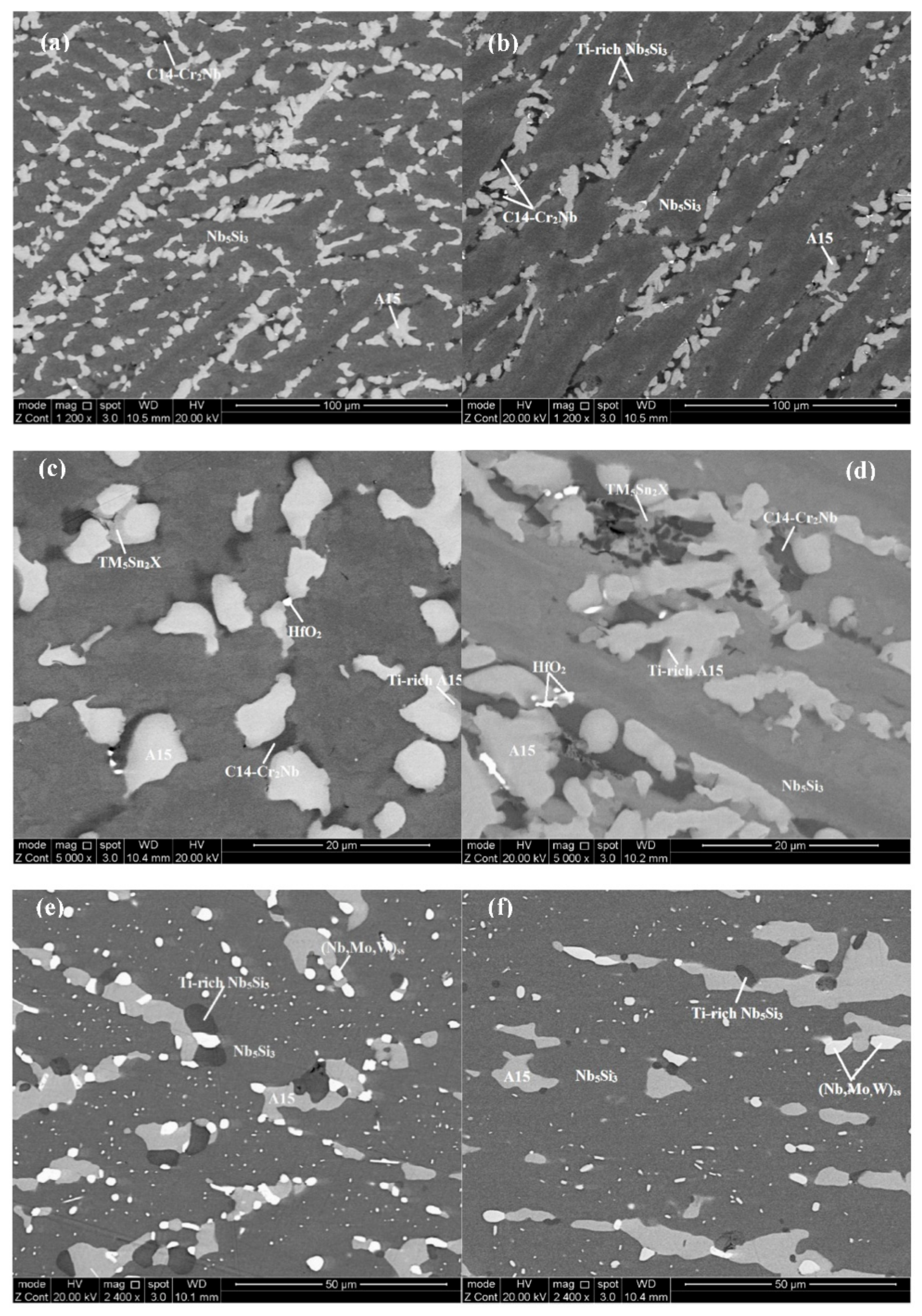
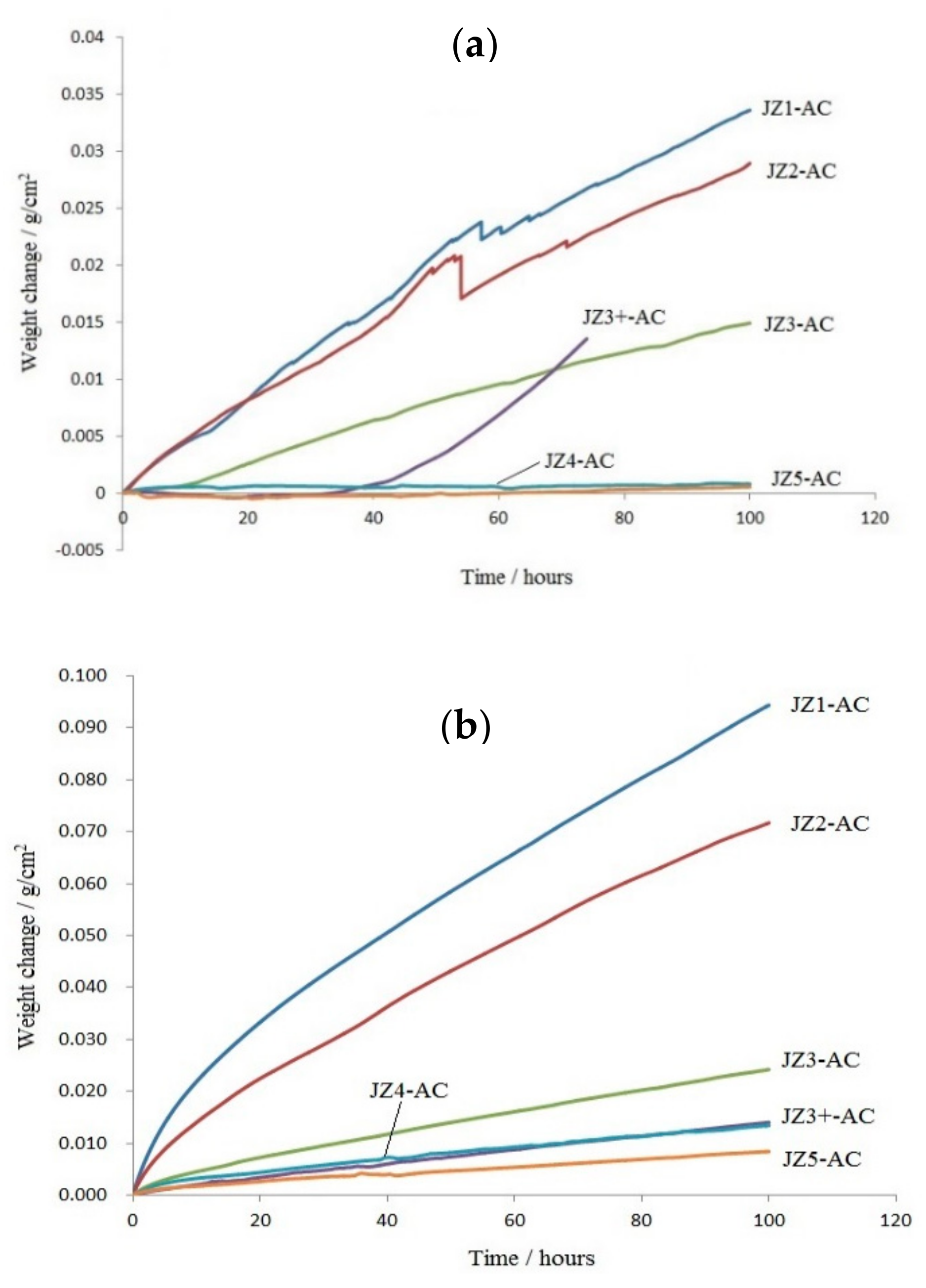

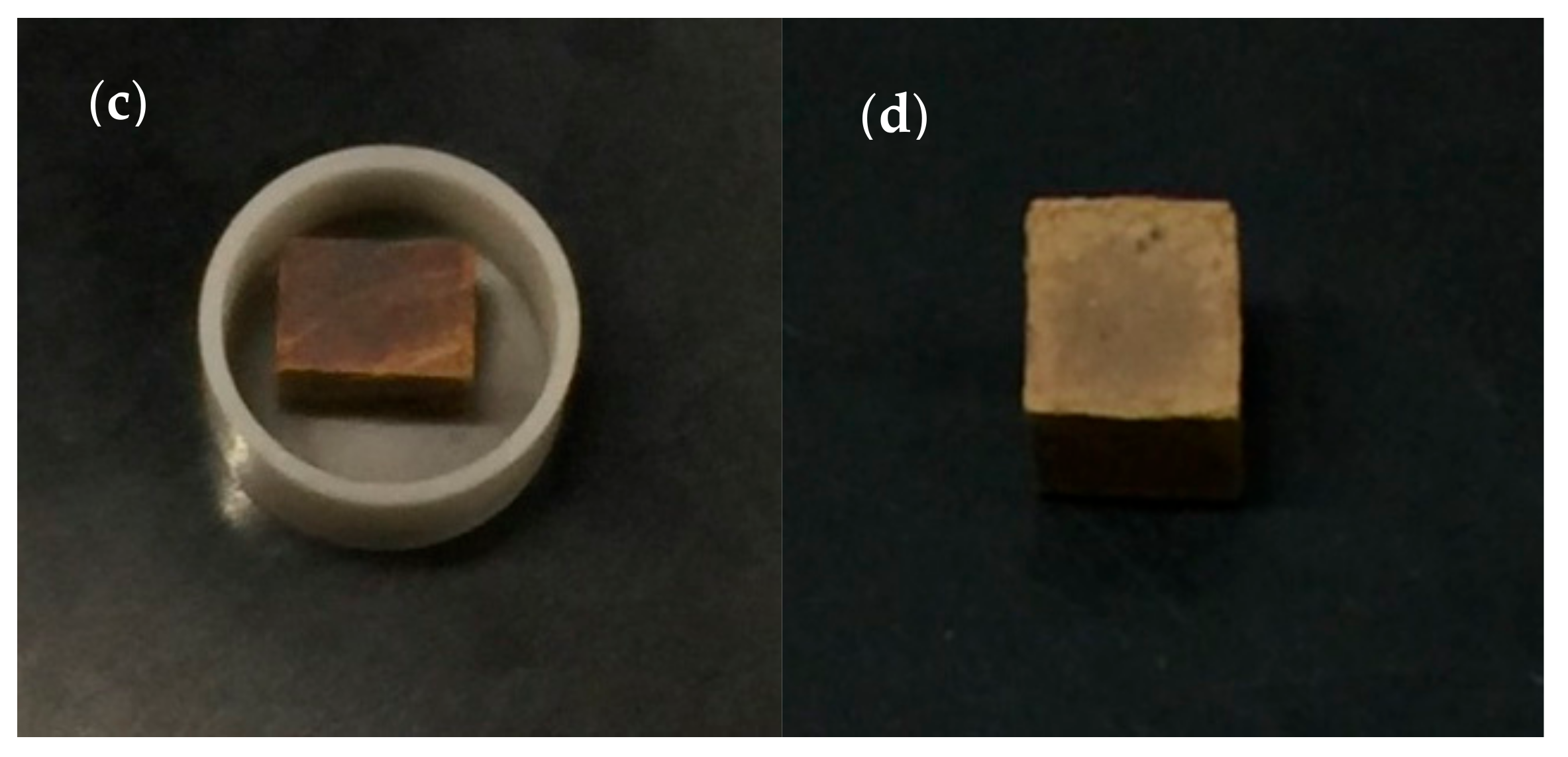



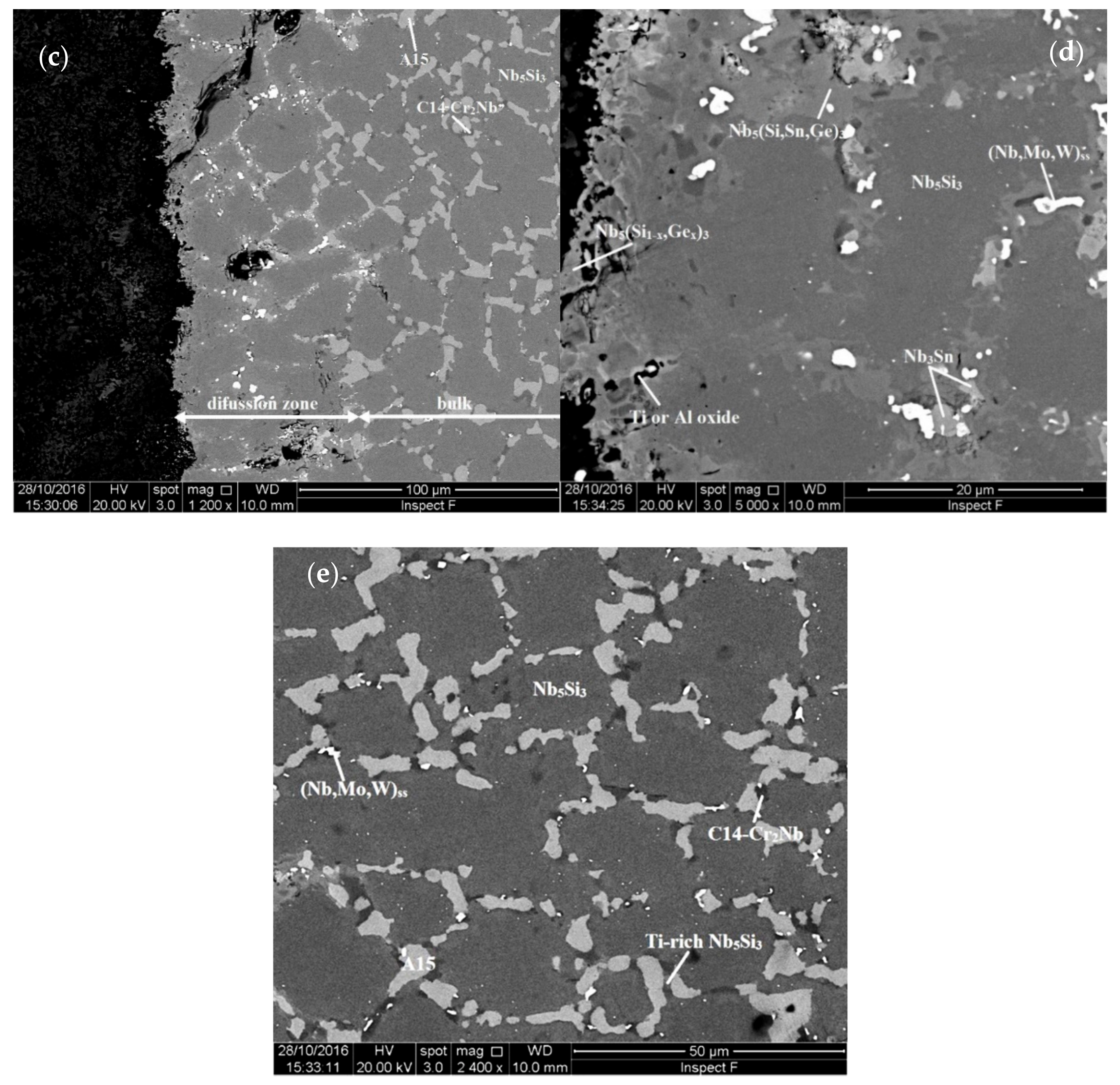
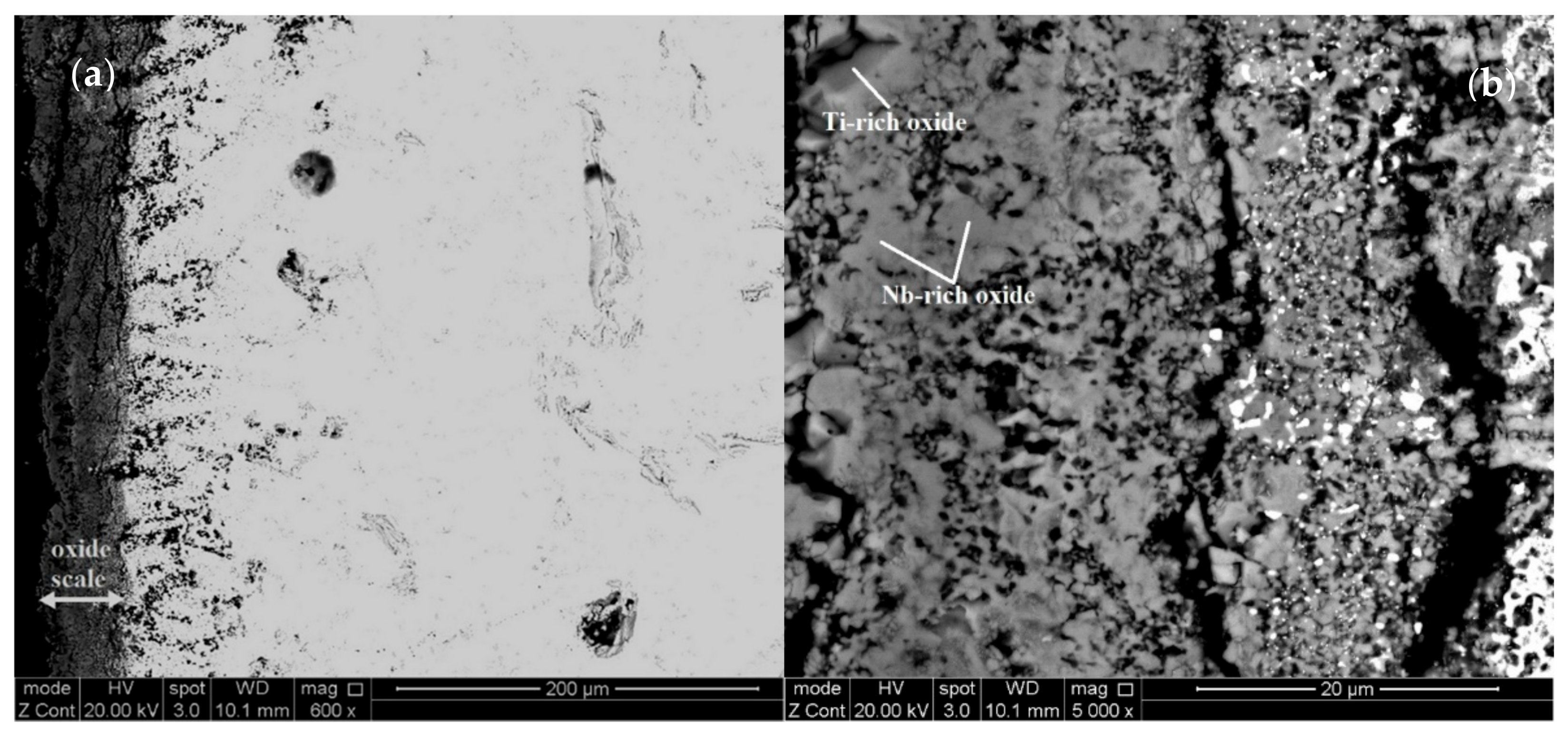

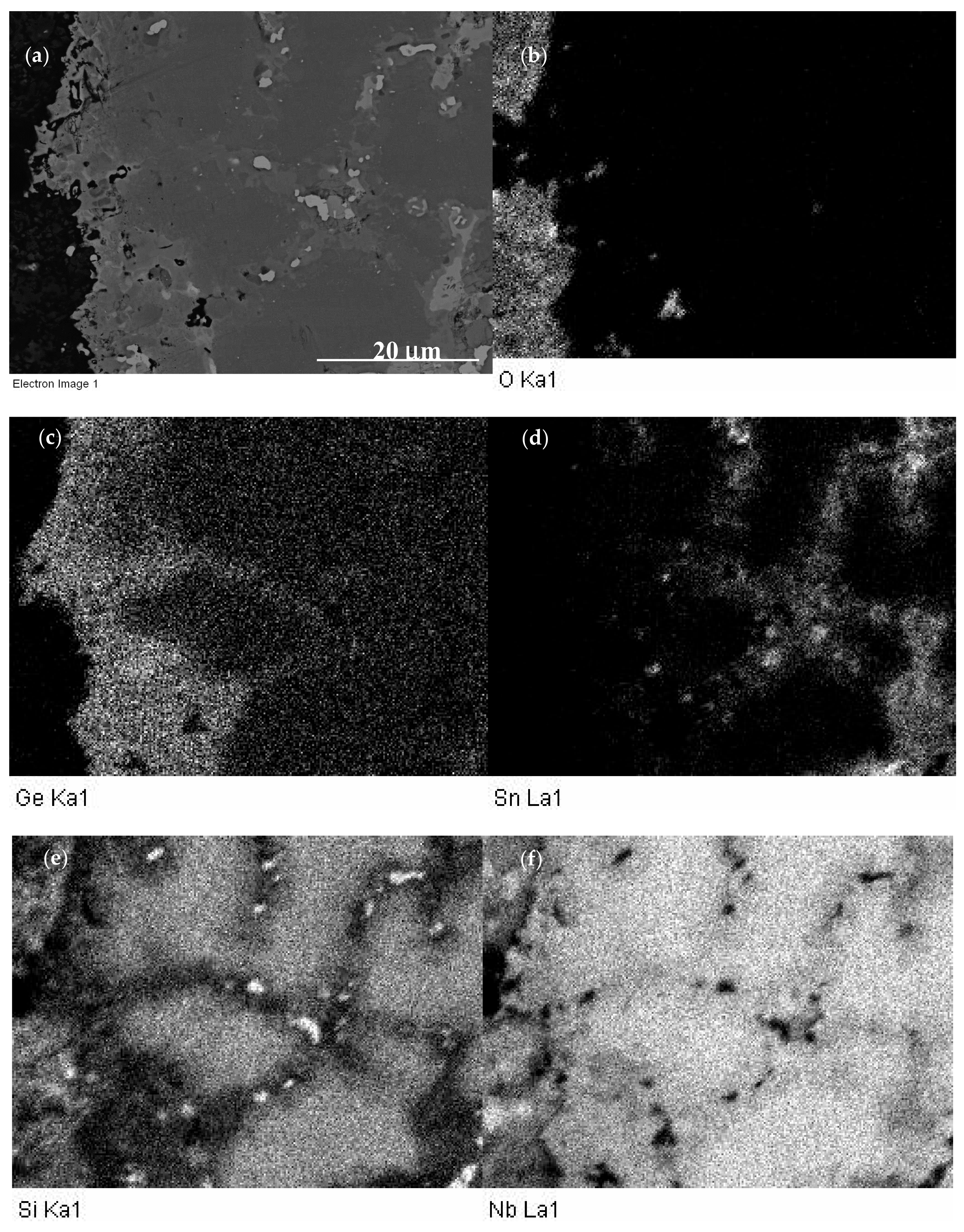
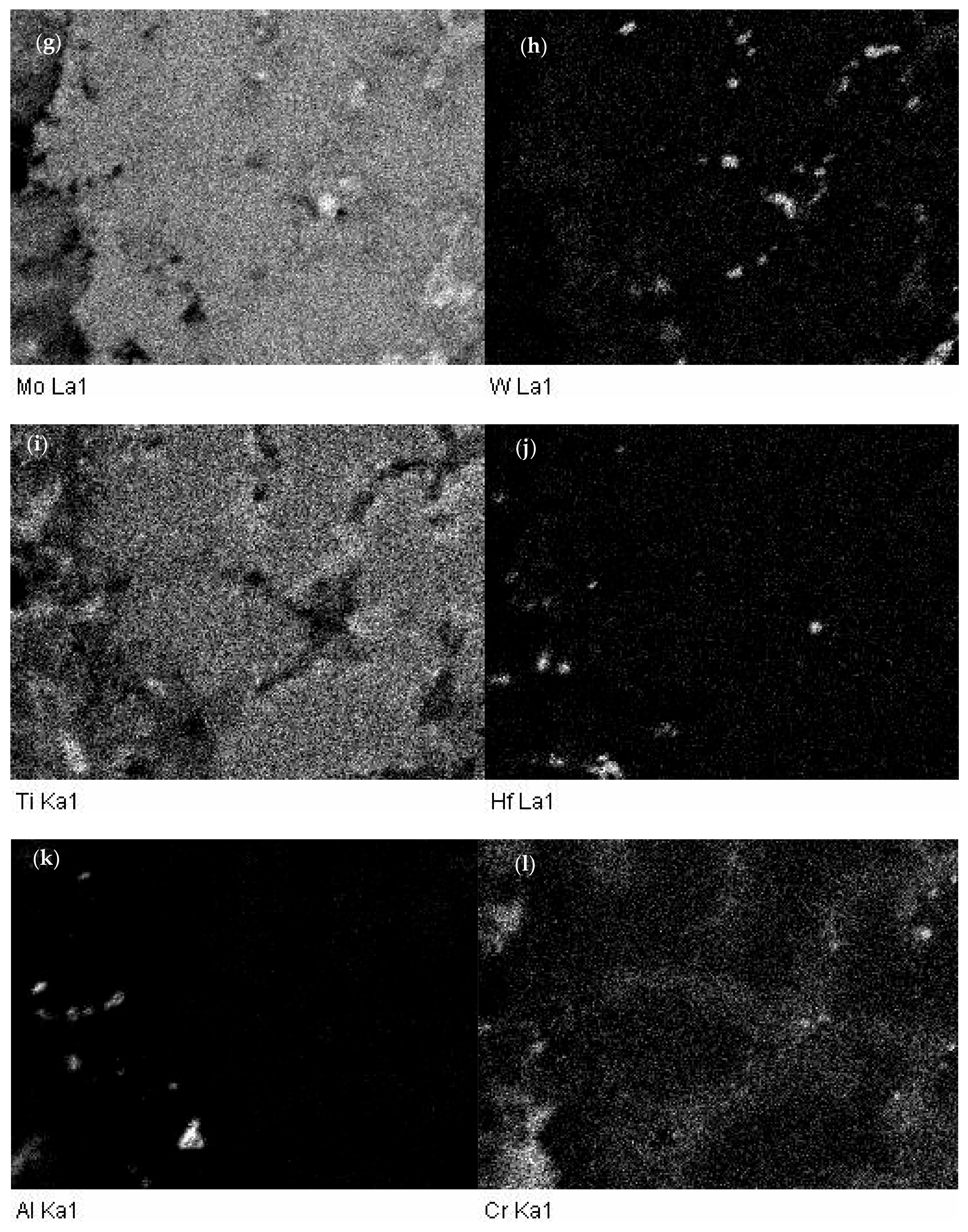
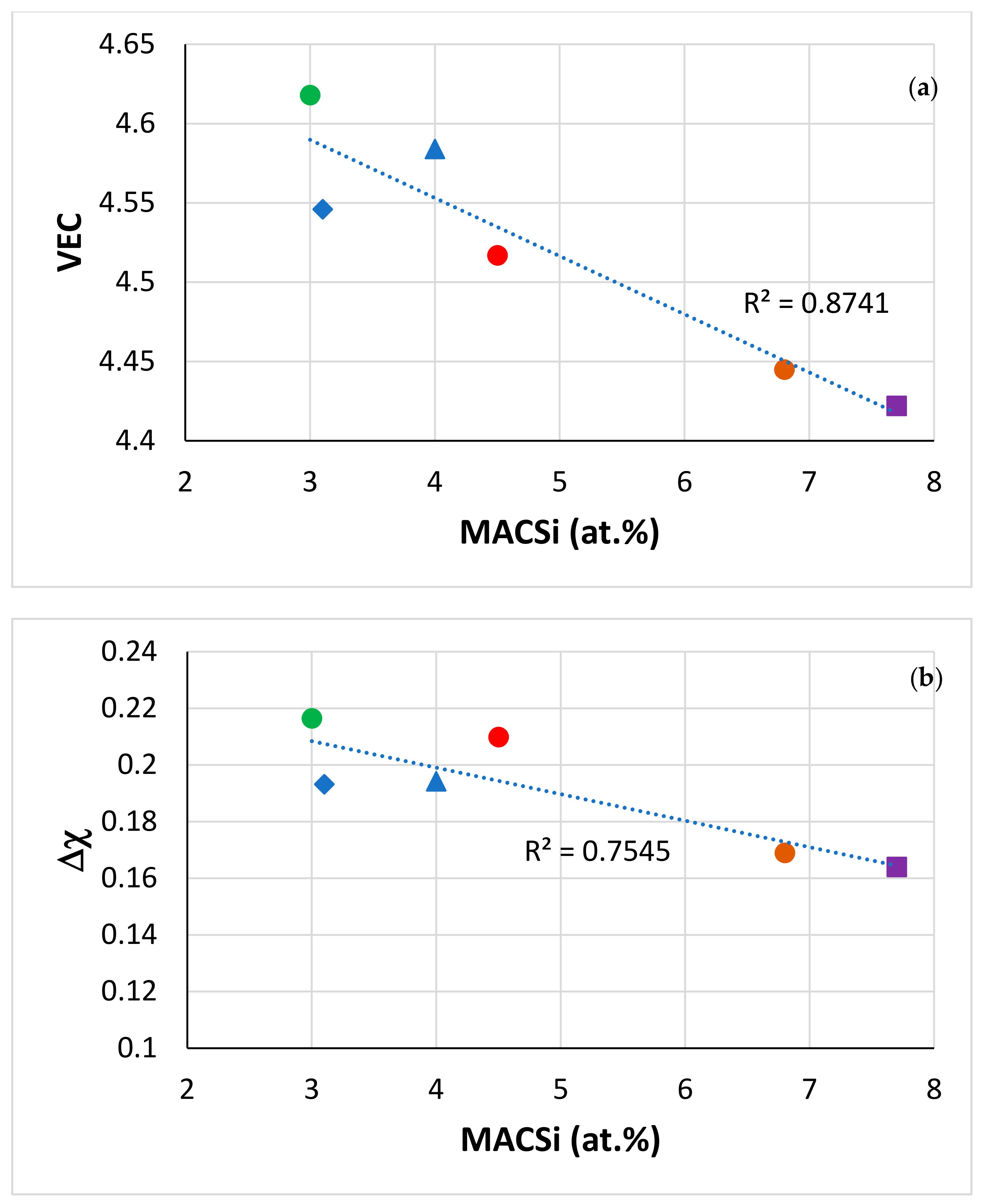
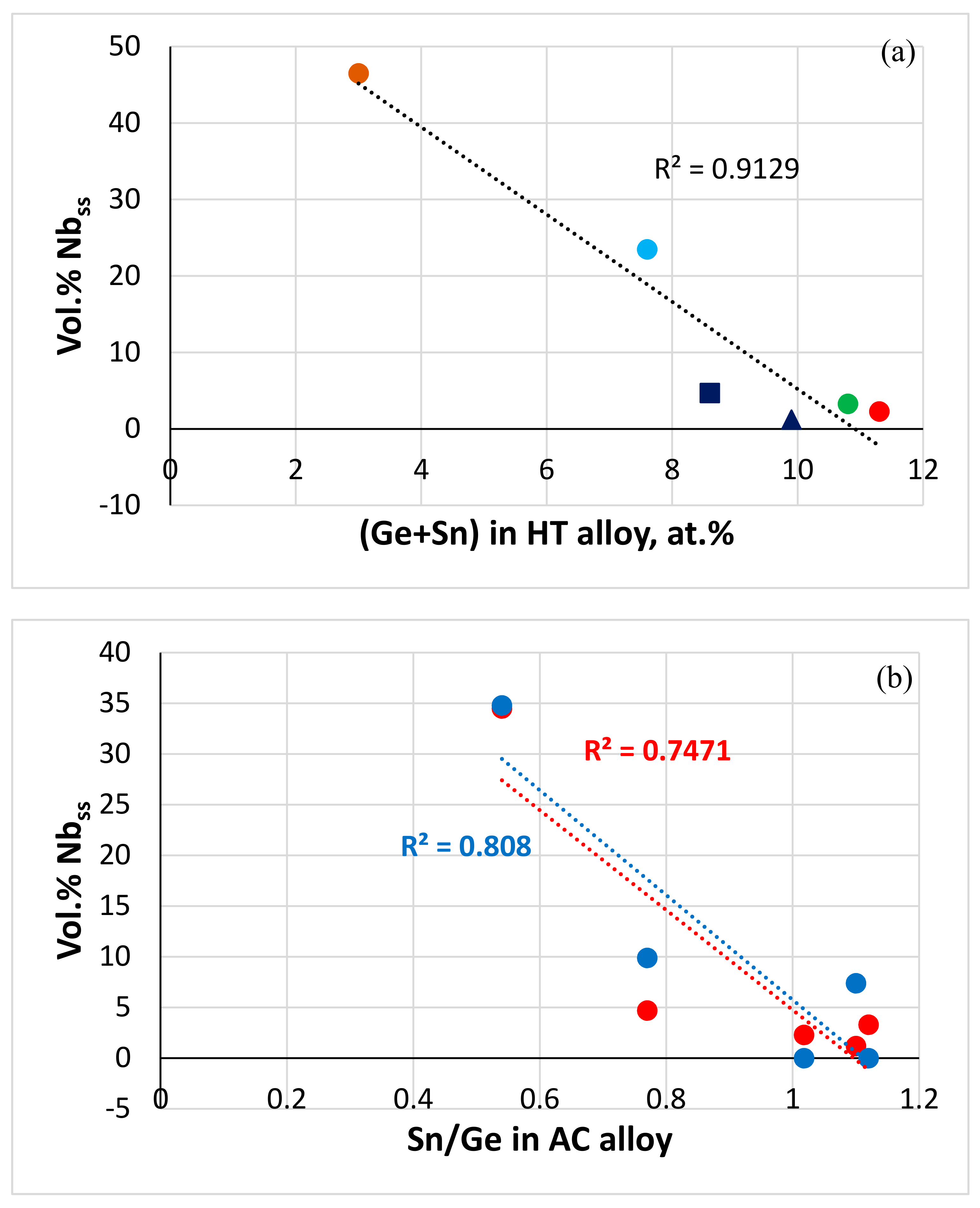
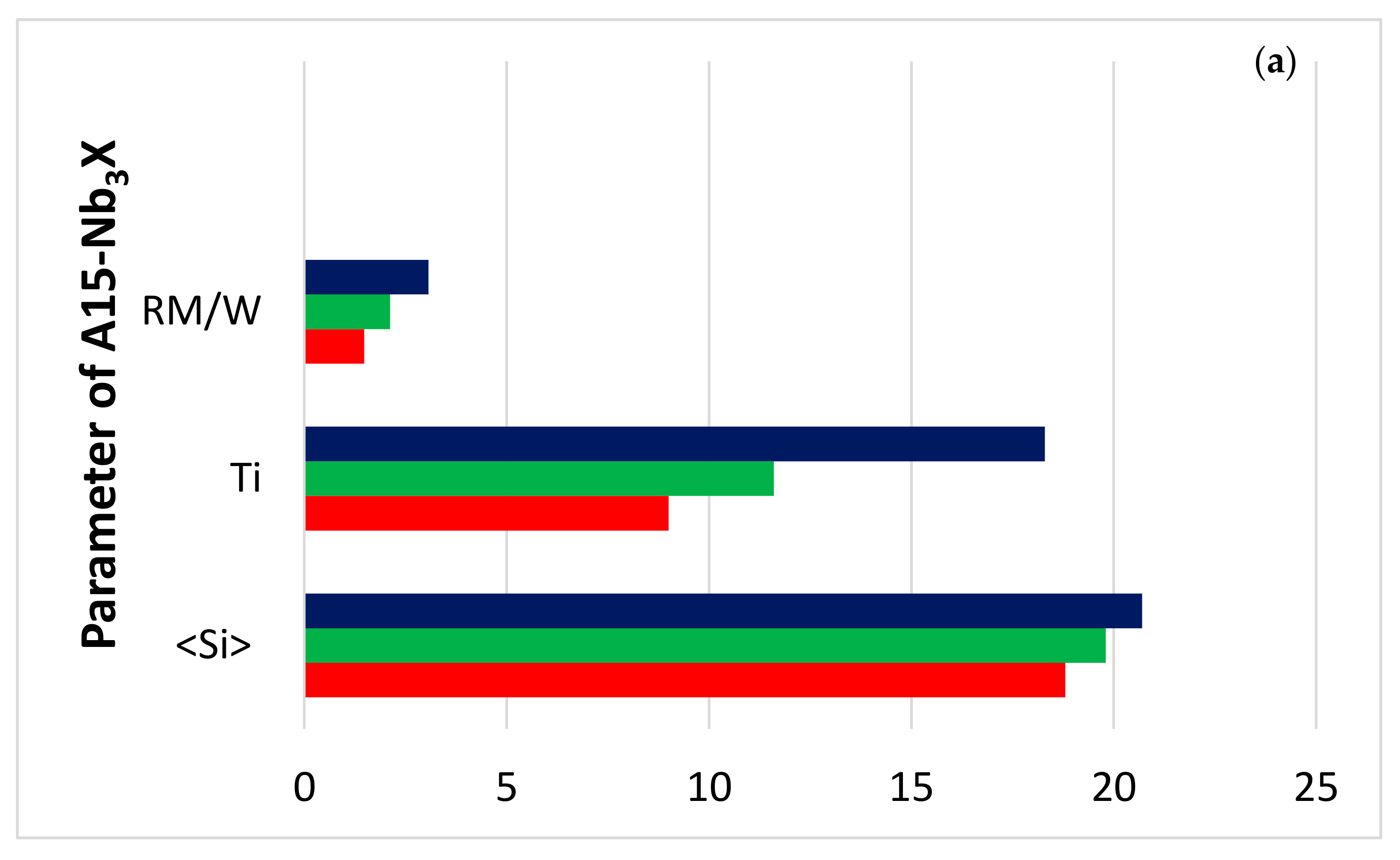
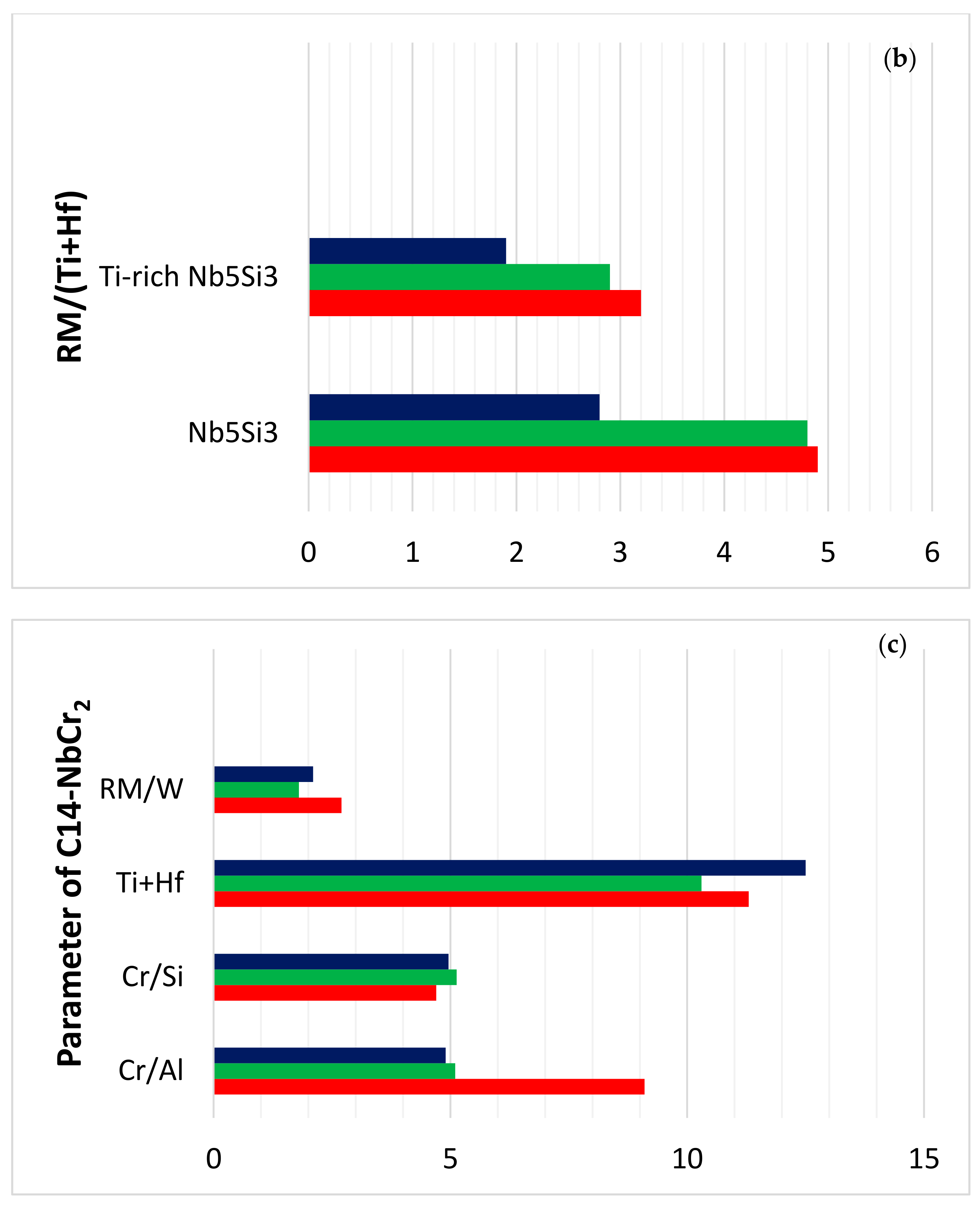
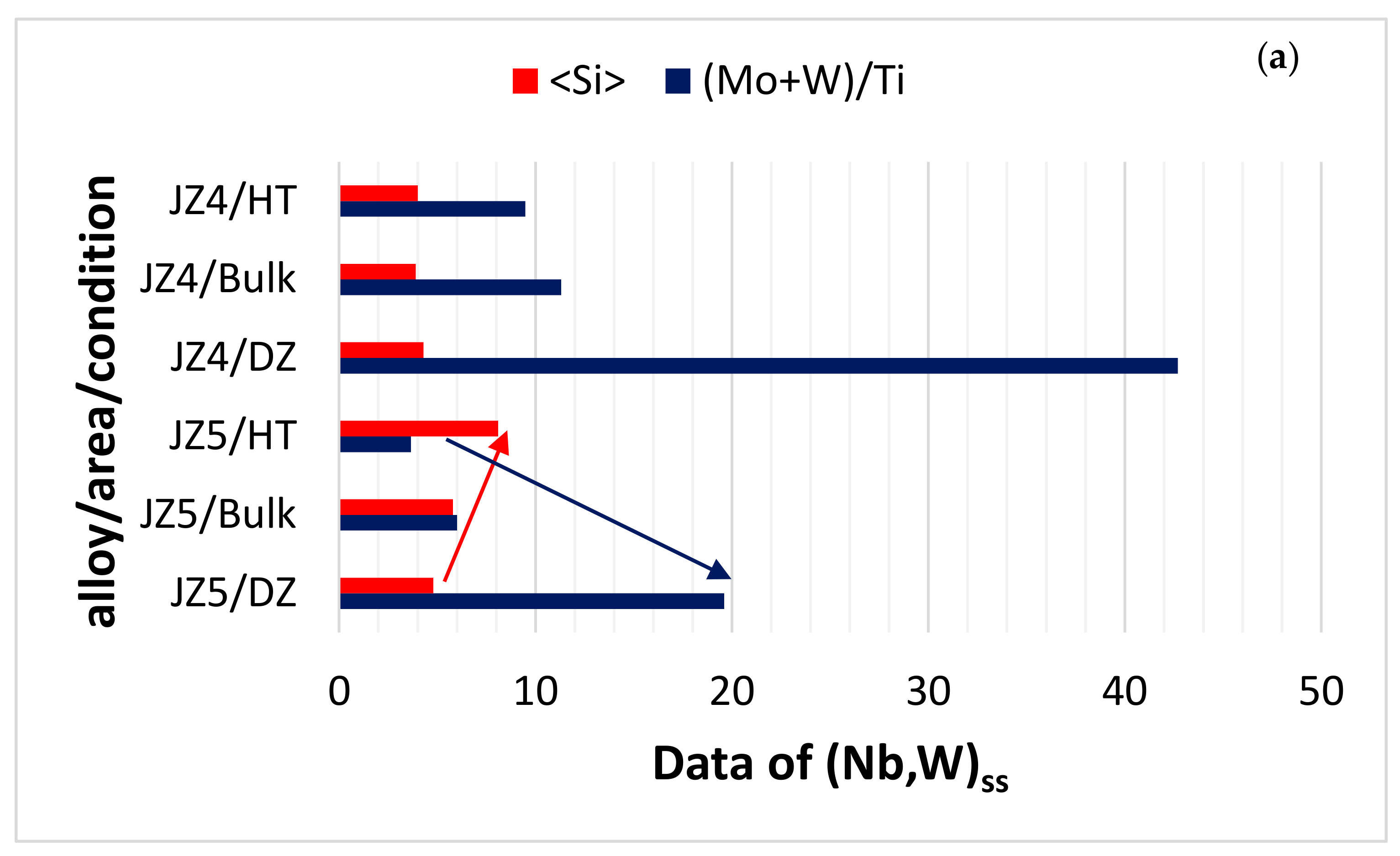

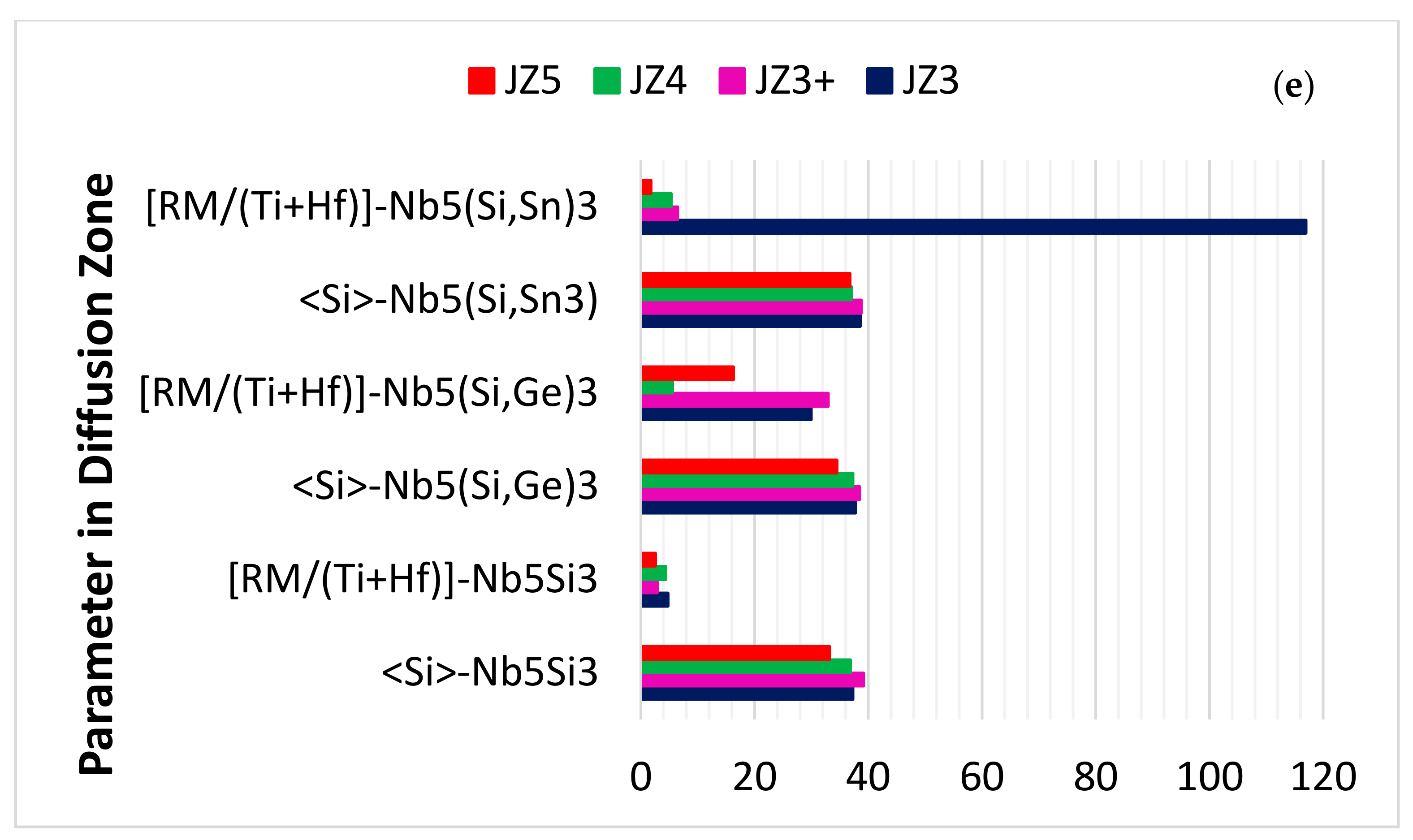
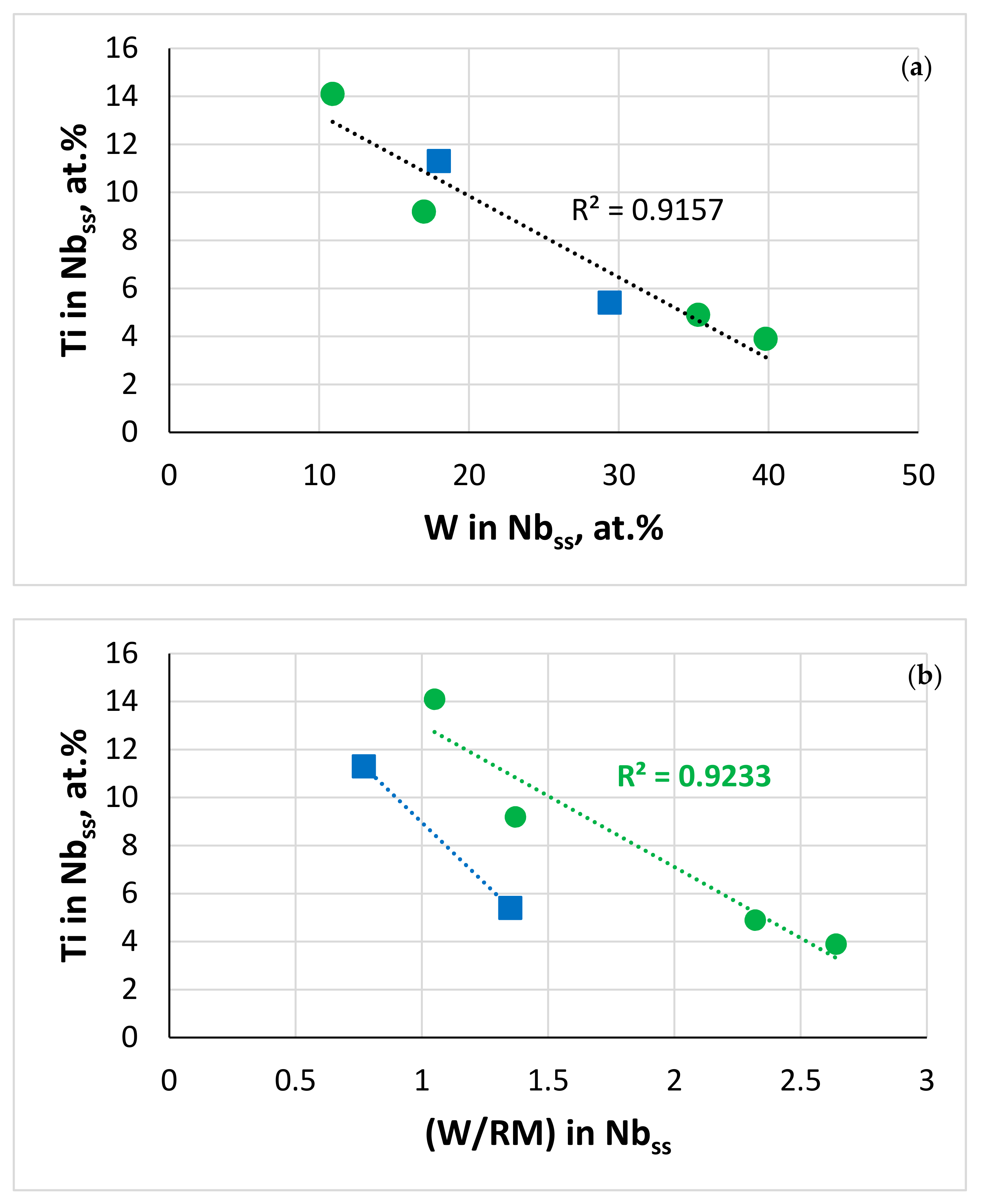
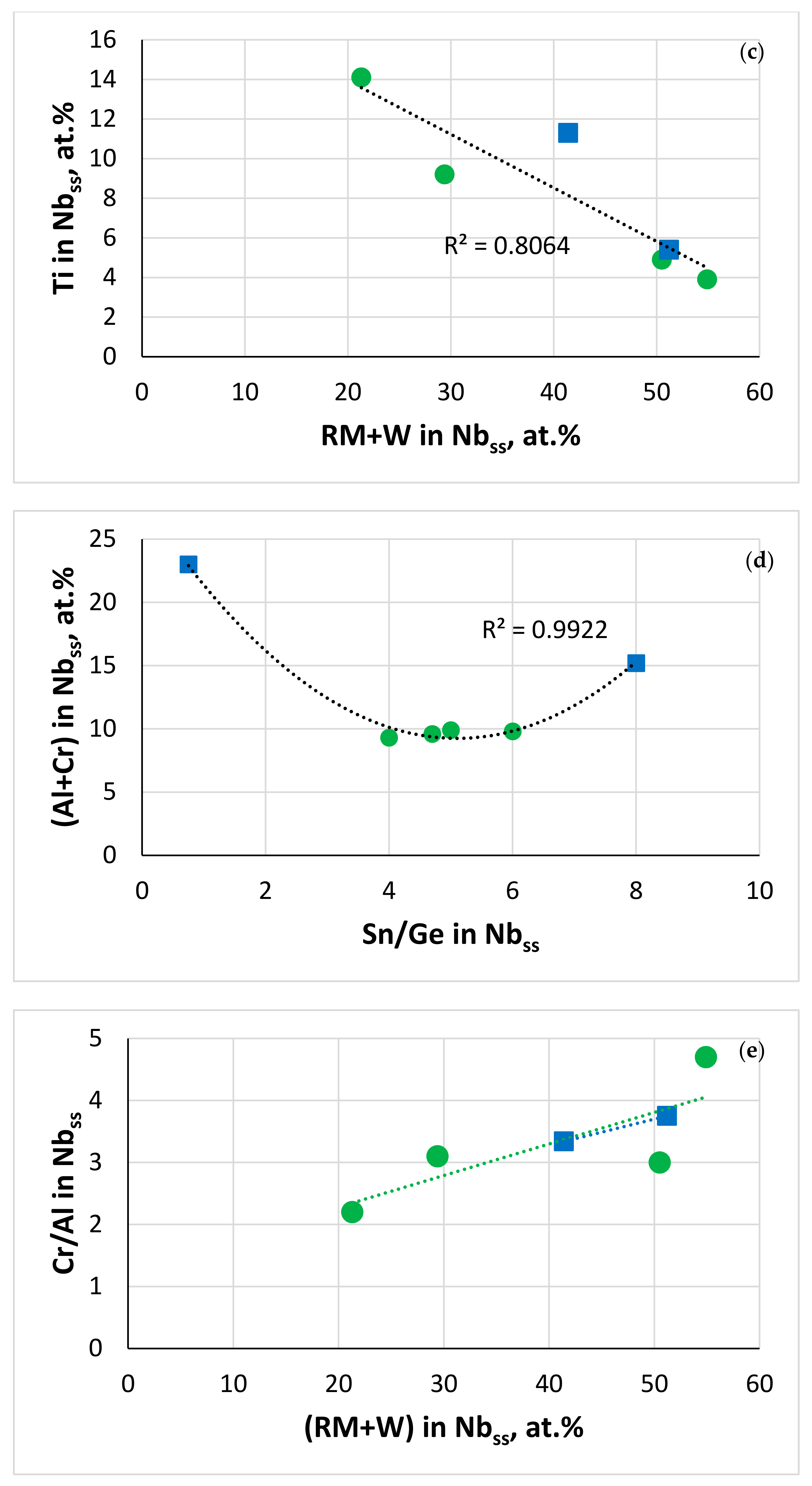
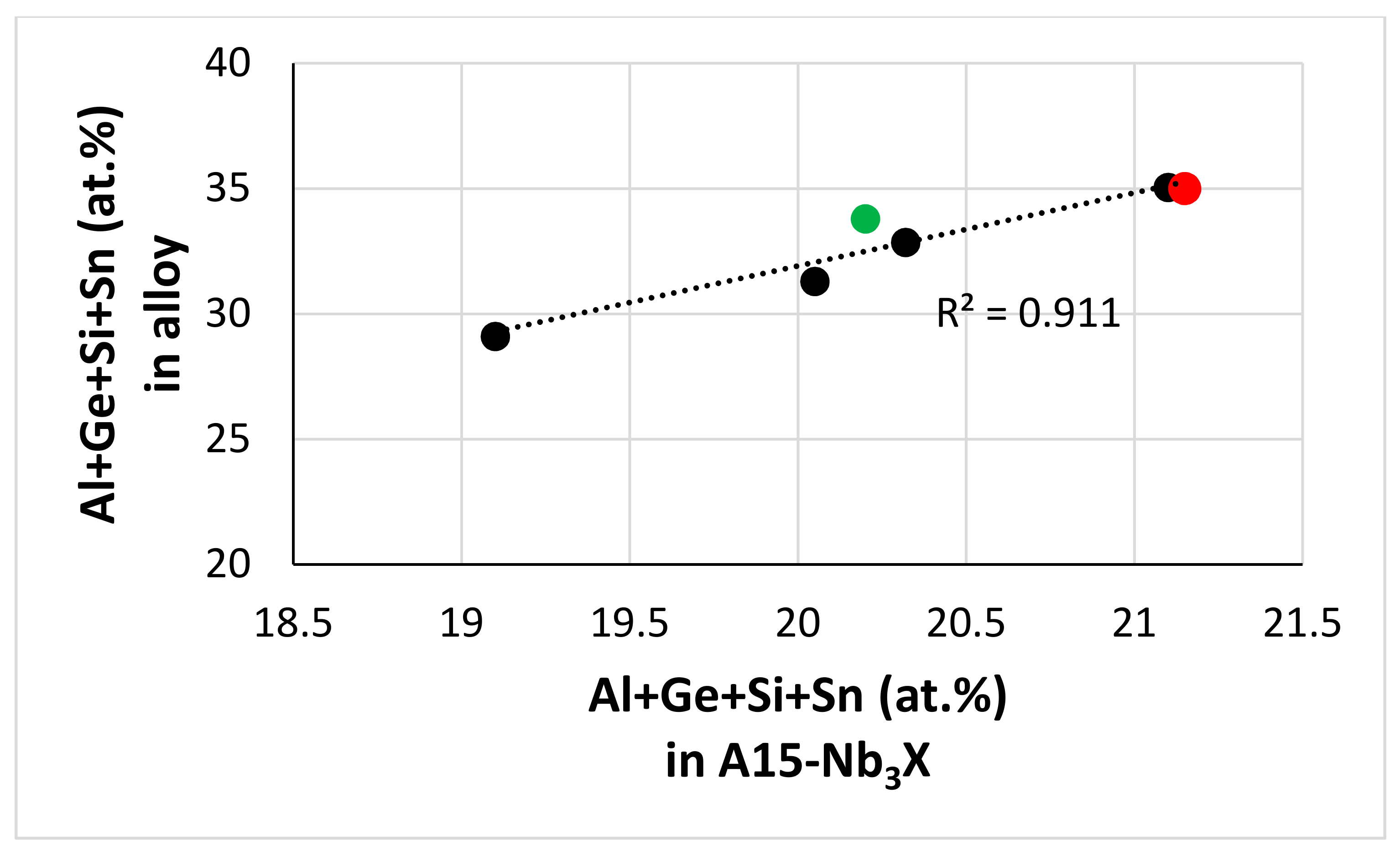
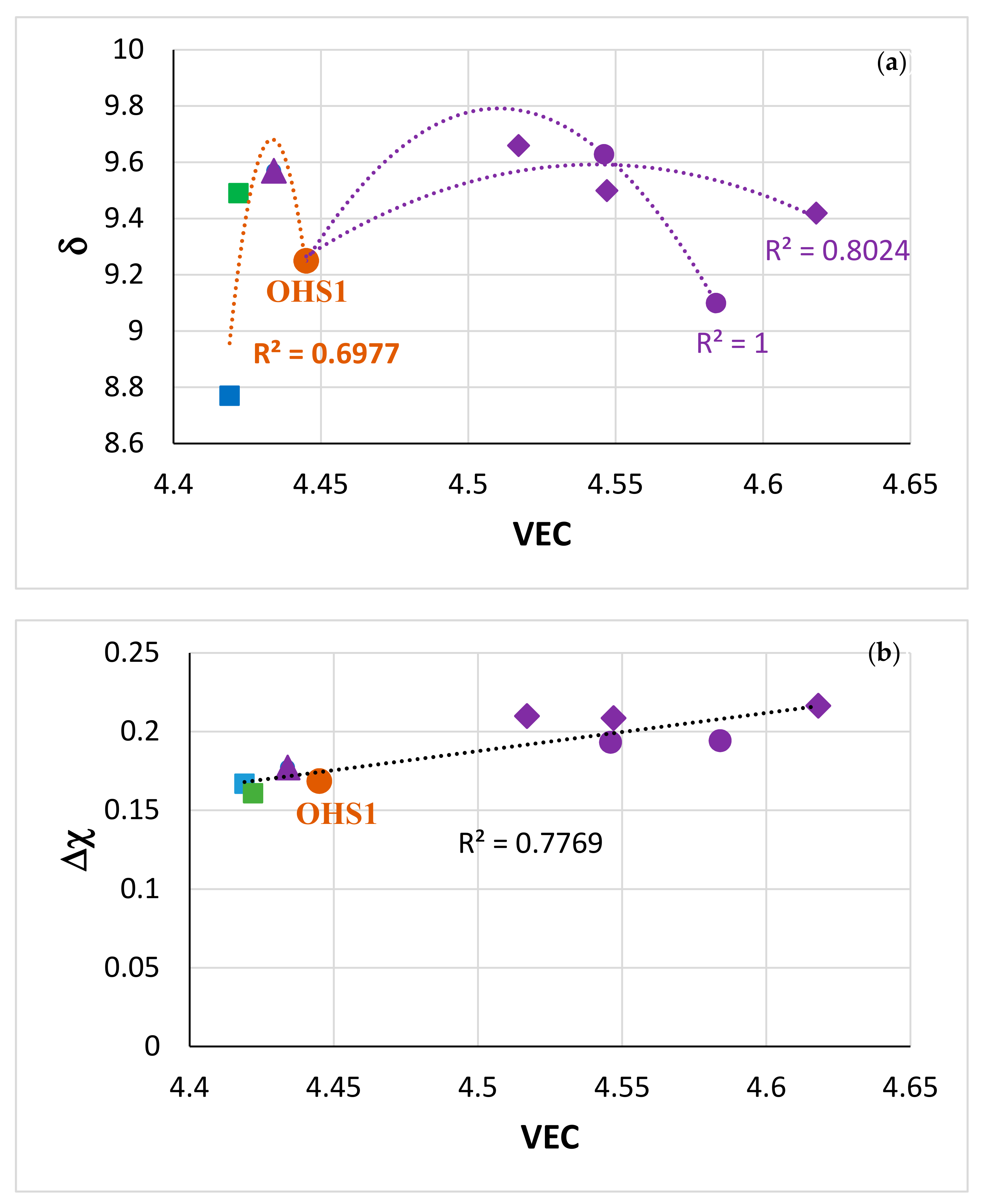

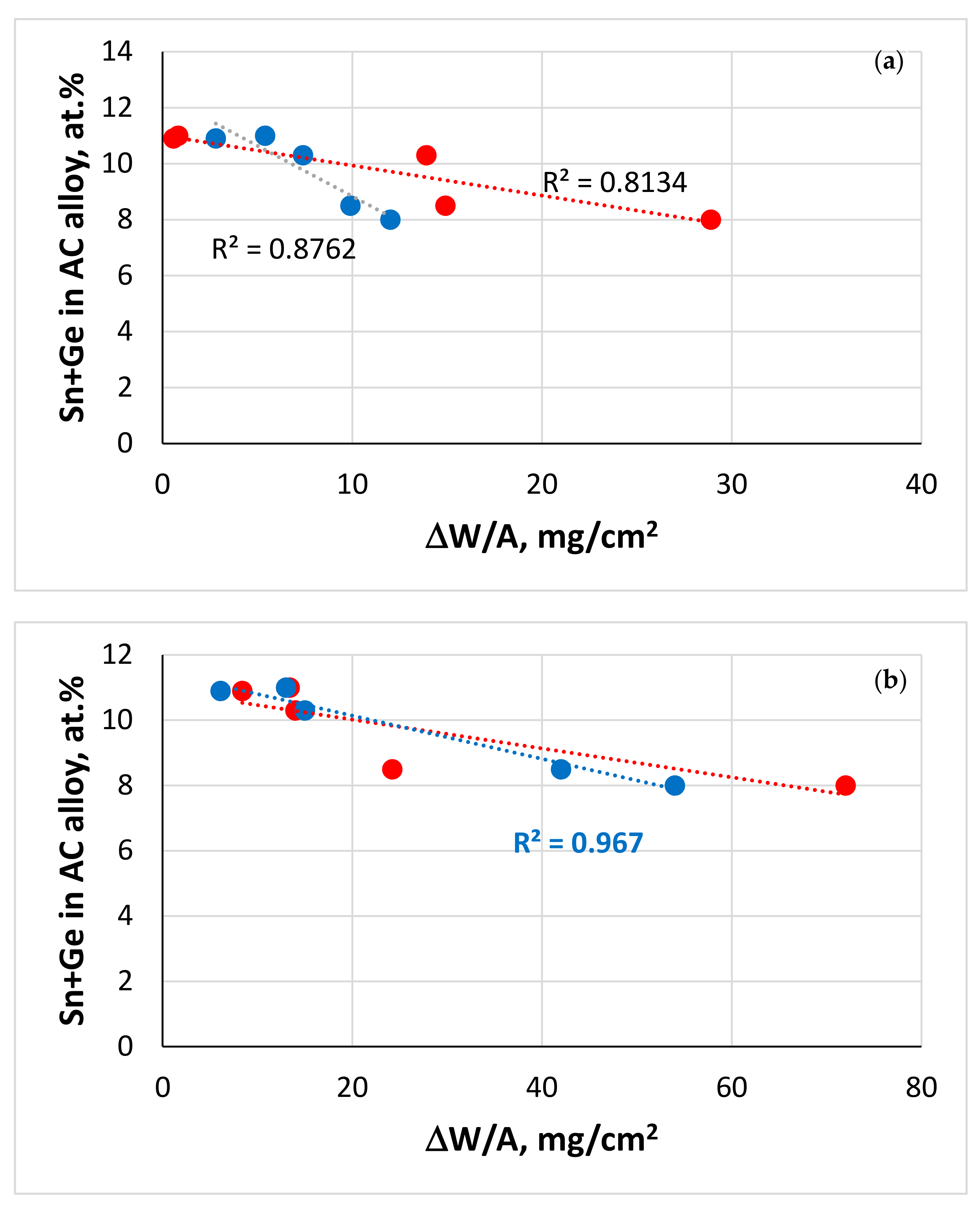
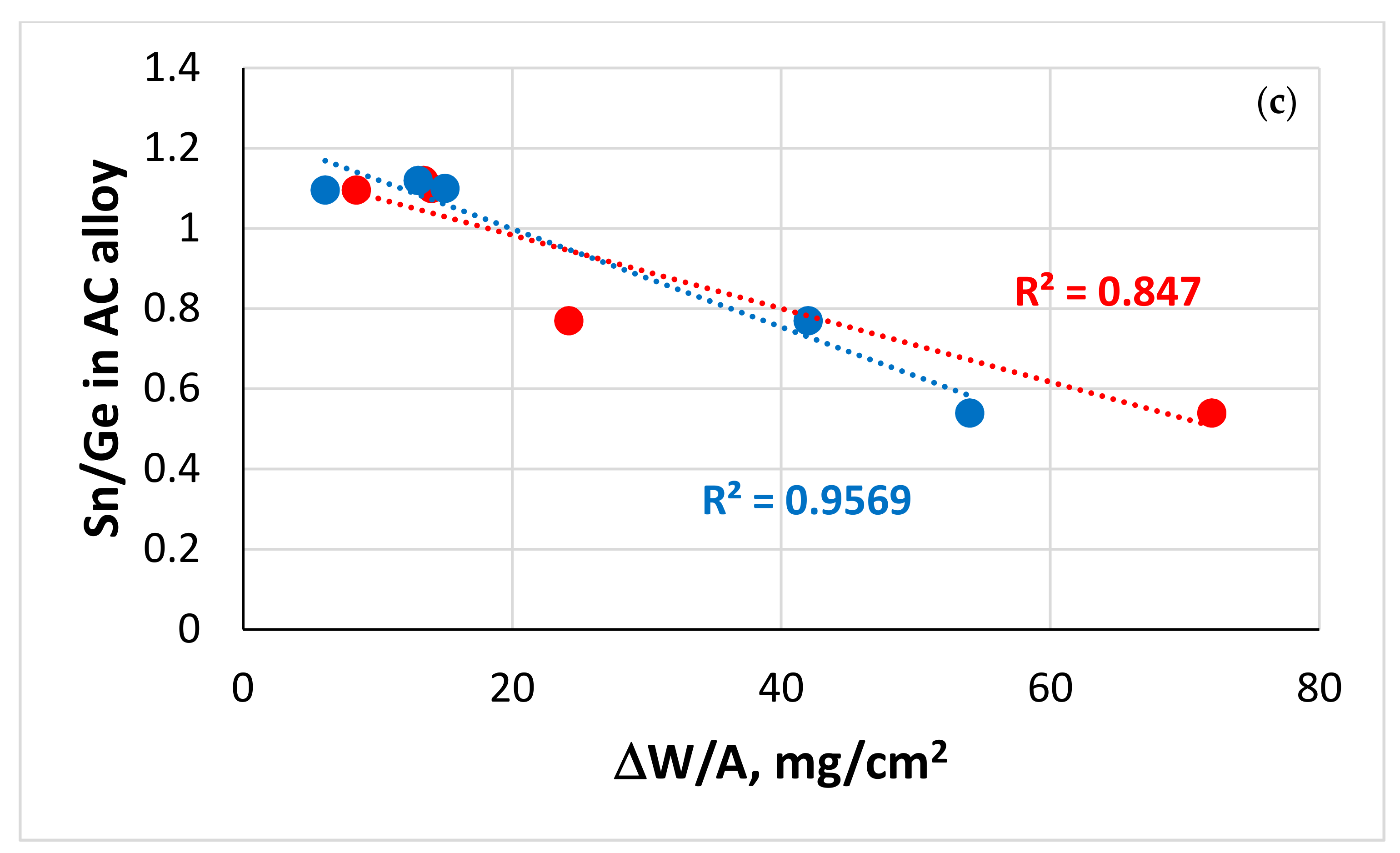
| Alloy | Density (g/cm3) | Solid Solution (%) | A15 (%) |
|---|---|---|---|
| JZ4-AC | 7.28 ± 0.01 | - | 19.8 ± 3.2 |
| 7.27–7.29 | 17.3–23.4 | ||
| JZ4-HT a | - | 3.3 ± 0.5 | 12.2 ± 2.0 |
| 2.7–3.6 | 10.9–14.5 | ||
| JZ5-AC | 6.91 ± 0.06 | - | 12.7 ± 1.1 |
| 6.87–7.01 | 11.4–13.4 | ||
| JZ5-HT a | - | 2.3 ± 0.3 | 10.6 ± 0.3 |
| 2.1–2.6 | 10.4–10.9 |
| Alloy | |
|---|---|
| JZ4 | JZ5 |
| As Cast | |
| Nb-12.5Ti-17.8Si-6.2Mo-2.3W-5.8Sn-5.2Ge-1.1Hf-5Al-5.2Cr | Nb-20.4Ti-19.2Si-6.3Mo-1.1W-5.7Sn-5.2Ge-0.9Hf-4.5Al-4.7Ge |
| Nb5Si3, Ti-rich Nb5Si3 | Nb5Si3, Ti-rich Nb5Si3 |
| A15-Nb3X, Ti-rich A15 | A15-Nb3X, Ti-rich A15 |
| TM5Sn2X | TM5Sn2X |
| C14-NbCr2 Laves | C14-NbCr2 Laves |
| HfO2 | HfO2 |
| Heat Treated | |
| Nb-12.3Ti-18.2Si-5.8Mo-2.2W-5.4Sn-5.4Ge-1.2Hf-4.8Al-4.8Cr | Nb-20.5Ti-18.8Si-6.2Mo-1.2W-5.7Sn-5.6Ge-1Hf-4.7Al-4.9Cr |
| (Nb,W)ss | (Nb,W)ss |
| Nb5Si3, Ti-rich Nb5Si3 | Nb5Si3, Ti-rich Nb5Si3 |
| A15-Nb3X | A15-Nb3X |
| C14-NbCr2 Laves | |
| HfO2 | HfO2 |
| Alloy | Weight Gain (mg/cm2) | Rate Constant kp (g2 cm−4 s−1) | Weight Gain (mg/cm2) | Rate Constant kp (g2 cm−4 s−1) |
|---|---|---|---|---|
| 800 °C | 1200 °C | |||
| JZ4 | 0.82 (100 h) | 1.02 × 10−12 (0–100 h) | 13.43 (100 h) | 5.04 × 10−10 (0–100 h) |
| 9.9 × 10−12 (0–9 h) | 2.92 × 10−10 (0–14 h) | |||
| 9.4 × 10−13 (9–100 h) | 5.44 × 10−10 (14–100 h) | |||
| JZ5 | 0.57 (100 h) | 7.33 × 10−12 (0–100 h) 1.2 × 10−11 (45–100 h) | 8.43 (100 h) | 1.92 × 10−10 (0–100 h) 9.46 × 10−11 (0–9 h) 2.04 × 10−10 (9–100 h) |
| Alloy/RCCA | Stable Phases # | ρ | 800 °C | 1200 °C | ||||
|---|---|---|---|---|---|---|---|---|
| ΔW/A | Pest | Rate Constant | ΔW/A | SP + | Rate Constant | |||
| JG6 | 5-3, A15, C14 | 6.96 | 1.8 | No | Kp = 1 × 10−11 | 90 | Yes * | Kl = 2.8 × 10−7 |
| EZ8 | 5-3, A15, C14 | 6.89 | 1 | No | Kl = 2 × 10−9 (>20 h) | 14 | Yes | Kp = 6 × 10−10 |
| Kp = 5.3 × 10−9 (≤20 h) | ||||||||
| ZF9 | ss, | 6.96 | 0.55 | No | Kp = 8.4 × 10−13 | 42 | Yes | Kp = 1.8 × 10−9 (≤20 h) |
| 5-3 | Kl = 1 × 10−7 (>20 h) | |||||||
| OHS1 | 5-3, A15, C14 | 6.78 | 3.2 | No | Kp = 2.4 × 10−11 | 31.3 | No | Kl = 1.1 × 10−7 (>3.1 h) |
| Kp = 4.9 × 10−10 (≤3.1 h) | ||||||||
| JZ3 | ss, 5-3, A15, C14 | 7.94 | 14.9 | No | Kl = 4.4 × 10−8 | 24.2 | Edge cracks | Kl = 6 × 10−8 |
| JZ3+ | ss, 5-3, A15, C14 | 7.54 | 13.9 | Yes | Kl = 6.5 × 10−9 | 14 | No | Kp = 5.5 × 10−10 |
| JZ4 | ss, 5-3, A15, C14 | 7.28 | 0.82 | No | Kp = 1 × 10−12 | 13.4 | No | Kp = 5 × 10−10 |
| JZ5 | ss, 5-3, A15, C14, | 6.91 | 0.57 | No | Kp = 7.3 × 10−12 | 8.4 | No | Kp = 1.9 × 10−10 |
| Alloy | ΔHm (kJ/mol) | Tm (K) | ΔHm/Tm (J/molK) | ΔHmsd/ΔHmsp | Tmsd (K) | Tmsp (K) | Tmsd/Tmsp | [ΔHm/Tm] × [ΔHmsd/ΔHmsp]−1 | MACSi (at.%) | ||||||||
|---|---|---|---|---|---|---|---|---|---|---|---|---|---|---|---|---|---|
| JZ5 | 28.4 | 2082 |  | 13.65 |  | 1.33 |  | 1624 |  | 458 |  | 3.55 |  | 10.26 |  | 4.5 |  |
| ZF9 | 27.71 | 2143 | 12.93 | 1.58 | 1755 | 388 | 4.52 | 8.18 | 3.1 | ||||||||
| JG6 | 27.06 | 2154 | 12.8 | 1.66 | 1771 | 383 | 4.62 | 7.71 | 3 | ||||||||
| JG4 | 28.33 | 2239 | 12.65 | 1.84 | 1877 | 362 | 5.19 | 6.88 | 2.7 | ||||||||
| JG3 | 27.92 | 2245 | 12.44 | 2 | 1905 | 340 | 5.6 | 6.22 | 2.6 | ||||||||
| KZ5 | 27.5 | 2239 | 12.28 | 2.05 | 1909 | 330 | 5.78 | 5.99 | 1.3 |
| Phase | Alloy | |||
|---|---|---|---|---|
| Diffusion Zone | JZ3 | JZ3+ | JZ4 | JZ5 |
| (Nb,W)ss | W/Ta = 3.15 | W/Ta = 3.64 | W/Mo = 1.48 | W/Mo = 1.24 |
| (Ta + W)/Ti = 152 | (Ta + W)/Ti = 258 | (Mo + W)/Ti = 42.7 | (Mo + W)/Ti = 19.6 | |
| <Si> = 5.5 | <Si> = 4.2 | <Si> = 4.3 | <Si> = 4.8 | |
| A15-Nb3X | <Si> = 25.8 | <Si> * | <Si> = 24.7 | <Si> = 23 |
| Ta/W = 2.1 | Ta/W * | Mo/W = 8.76 | Mo/W = 6.46 | |
| Nb5(Si,Ge)3 | <Si> = 37.8 | <Si> = 38.5 | <Si> = 37.3 | <Si> = 34.5 |
| RM/(Ti + Hf) = 30 | RM/(Ti + Hf) = 33 | RM/(Ti + Hf) = 5.6 | RM/(Ti + Hf) = 16.3 | |
| Nb5Si3 | <Si> = 37.3 | <Si> = 39.2 | <Si> = 36.9 | <Si> = 33.2 |
| RM/(Ti + Hf) = 4.8 | RM/(Ti + Hf) = 2.9 | RM/(Ti + Hf) = 4.4 | RM/(Ti + Hf) = 2.6 | |
| Nb5(Si,Sn)3 | <Si> = 38.6 | <Si> = 38.8 | <Si> = 37.1 | <Si> = 36.8 |
| RM/(Ti + Hf) = 117 | RM/(Ti+ Hf) = 6.5 | RM/(Ti + Hf) = 5.4 | RM/(Ti + Hf) = 1.8 | |
| Bulk | JZ3 | JZ3+ | JZ4 | JZ5 |
| (Nb,W)ss | − | − | W/Mo = 1.4 | W/Mo = 1.08 |
| (Mo + W)/Ti = 11.3 | (Mo + W)/Ti = 6 | |||
| <Si> = 3.9 | <Si> = 5.8 | |||
| W/Ta = 1.37 + | W/Ta = 2.64 + | W/Mo = 1.35 + | W/Mo = 0.77 + | |
| (Ta + W)/Ti = 3.2 + | (Ta + W)/Ti = 14.1 + | (Mo + W)/Ti = 9.48 + | (Mo + W)/Ti = 3.66 + | |
| <Si> = 7.3 + | <Si> = 3.9 + | <Si> = 4 + | <Si> = 8.1 + | |
| A15-Nb3X | <Si> = 19.7 | <Si> = 20.3 | <Si> = 20.1 | <Si> = 22.3 |
| Ta/W = 1.29 | Ta/W = 0.96 | Mo/W = 1.99 | Mo/W = 4.74 | |
| <Si> = 20.7 + | <Si> = 20.5 + | <Si> = 20.6 + | <Si> = 20.7 + | |
| Ta/W = 1.34 + | Ta/W = 1.26 + | Mo/W = 2.55 + | Mo/W = 3.47 + | |
| Nb5Si3 | <Si> = 38 | <Si> = 38.9 | <Si> = 36.2 | <Si> = 36.6 |
| RM/(Ti + Hf) = 4.6 | RM/(Ti + Hf) = 4.98 | RM/(Ti + Hf) = 4.5 | RM/(Ti + Hf) = 2.65 | |
| <Si> = 38.6 + | <Si> = 37.9 + | <Si> = 36.6 + | <Si> = 36.8 + | |
| RM/(Ti + Hf) = 4.82 + | RM/(Ti + Hf) = 3.23 + | RM/(Ti + Hf) = 2.46 + | RM/(Ti + Hf) = 1.44 + | |
| Ti-rich Nb5Si3 | <Si> = 37.9 | <Si> = 36.4 | <Si> = 35.9 | <Si> = 36.6 |
| RM/(Ti + Hf) = 2.99 | RM/(Ti + Hf) = 1.9 | RM/(Ti + Hf) = 1.87 | RM/(Ti + Hf) = 1.17 | |
| <Si> = 38.4 + | <Si> = 38.4 + | <Si> = 38.1 + | <Si> = 37.9 + | |
| RM/(Ti + Hf) = 2.48 + | RM/(Ti + Hf) = 2.06 + | RM/(Ti + Hf) = 1.84 | RM/(Ti + Hf) = 1.08 + | |
| C14-NbCr2 | <Cr> = 61.7 | <Cr> = 60.8 | <Cr> = 59.6 | <Cr> = 60.1 |
| Ta + W = 12.3 | Ta + W = 14.1 | Mo + W = 7 | Mo + W = 7.9 | |
| <Cr>/LFE = 1.77 | <Cr>/LFE = 1.75 | <Cr>/LFE = 1.78 | <Cr>/LFE = 1.88 | |
| <Cr> = 63.3 + | <Cr> = 62.1 + | <Cr> = 61.3 + | - | |
| Ta + W = 12.2 + | Ta + W = 14.8 + | Mo + W = 7.5 + | ||
| <Cr>/LFE = 1.94 + | <Cr>/LFE = 1.9 + | <Cr>/LFE = 1.79 + | ||
| Theory | Surface Segregating Element | |||||||
|---|---|---|---|---|---|---|---|---|
| A | Al | Cr | Si | Sn | Ge | Mo | Hf | Ti |
| B | Al | - | - | Sn | Ge | - | - | Ti |
| C | - | Cr | Si | Sn | Ge | - | - | - |
| D | Al | Cr | Si | Sn | Ge | - | Hf | Ti |
© 2020 by the authors. Licensee MDPI, Basel, Switzerland. This article is an open access article distributed under the terms and conditions of the Creative Commons Attribution (CC BY) license (http://creativecommons.org/licenses/by/4.0/).
Share and Cite
Zhao, J.; Utton, C.; Tsakiropoulos, P. On the Microstructure and Properties of Nb-18Si-6Mo-5Al-5Cr-2.5W-1Hf Nb-Silicide Based Alloys with Ge, Sn and Ti Additions (at.%). Materials 2020, 13, 4548. https://doi.org/10.3390/ma13204548
Zhao J, Utton C, Tsakiropoulos P. On the Microstructure and Properties of Nb-18Si-6Mo-5Al-5Cr-2.5W-1Hf Nb-Silicide Based Alloys with Ge, Sn and Ti Additions (at.%). Materials. 2020; 13(20):4548. https://doi.org/10.3390/ma13204548
Chicago/Turabian StyleZhao, Jiang, Claire Utton, and Panos Tsakiropoulos. 2020. "On the Microstructure and Properties of Nb-18Si-6Mo-5Al-5Cr-2.5W-1Hf Nb-Silicide Based Alloys with Ge, Sn and Ti Additions (at.%)" Materials 13, no. 20: 4548. https://doi.org/10.3390/ma13204548
APA StyleZhao, J., Utton, C., & Tsakiropoulos, P. (2020). On the Microstructure and Properties of Nb-18Si-6Mo-5Al-5Cr-2.5W-1Hf Nb-Silicide Based Alloys with Ge, Sn and Ti Additions (at.%). Materials, 13(20), 4548. https://doi.org/10.3390/ma13204548







